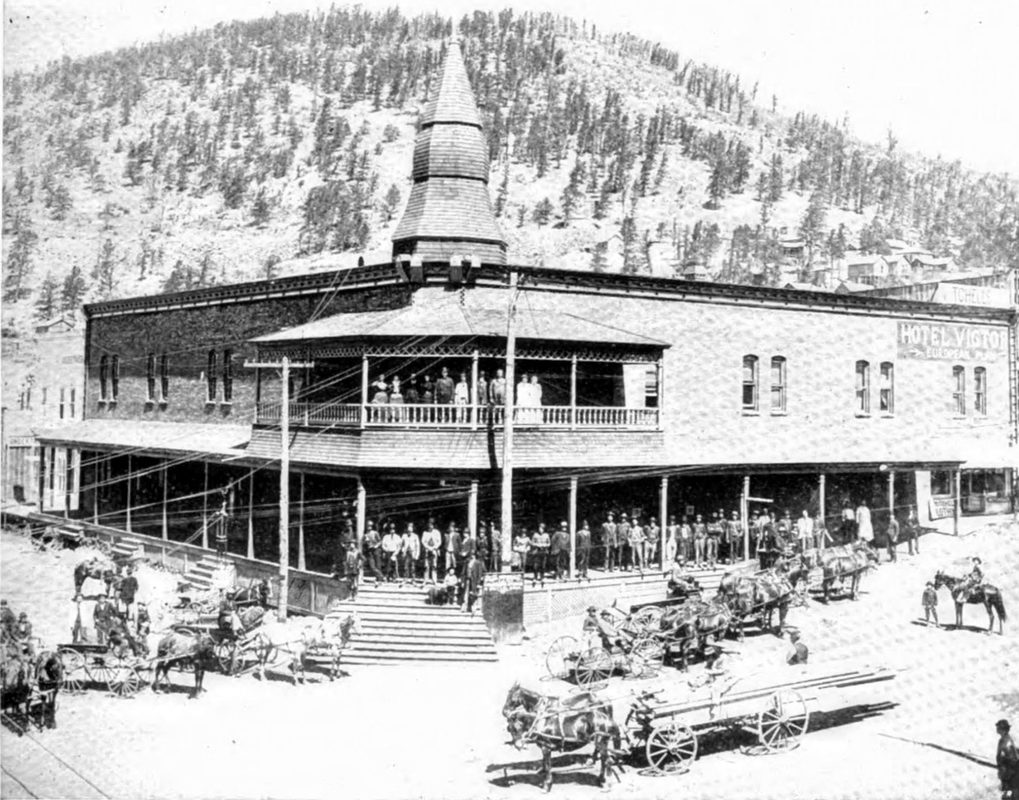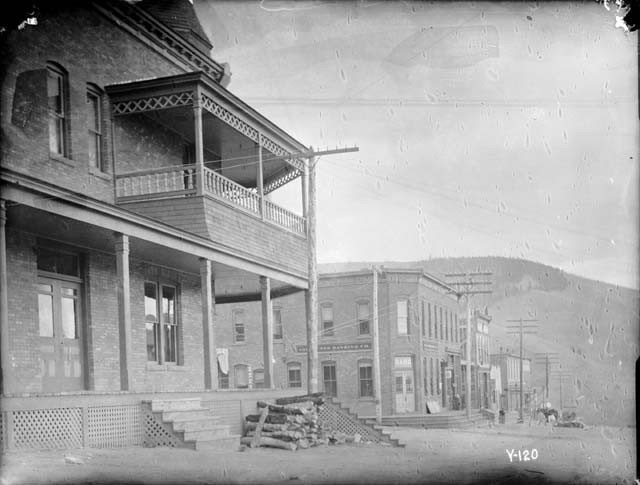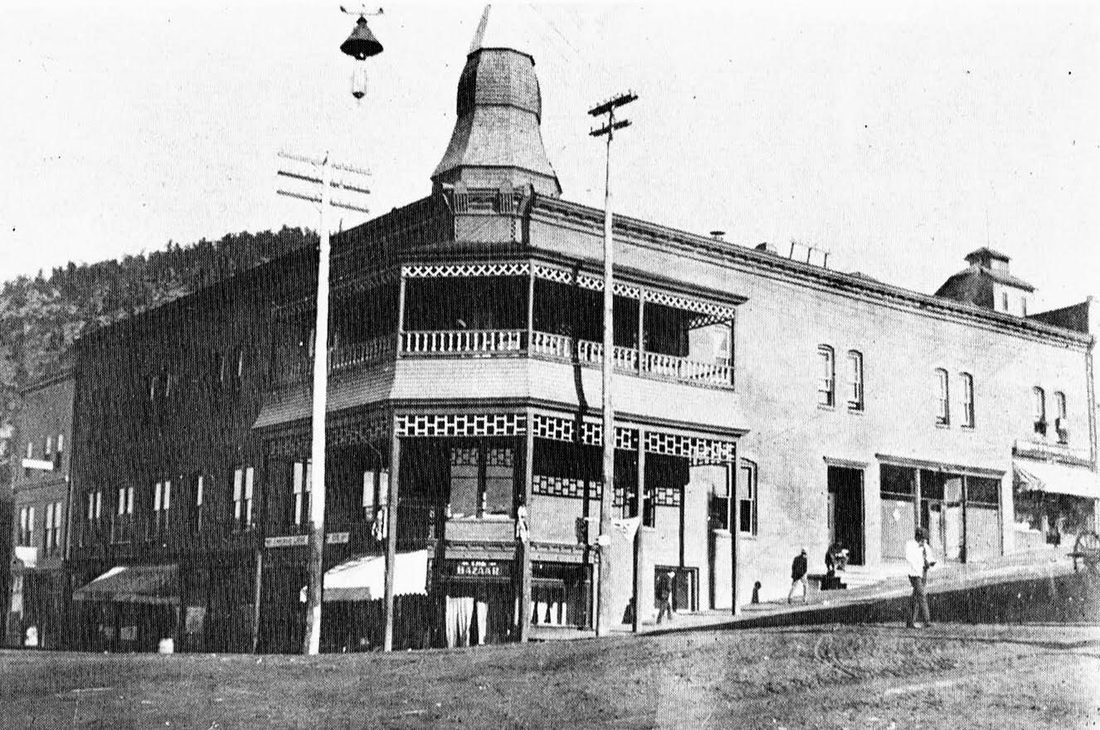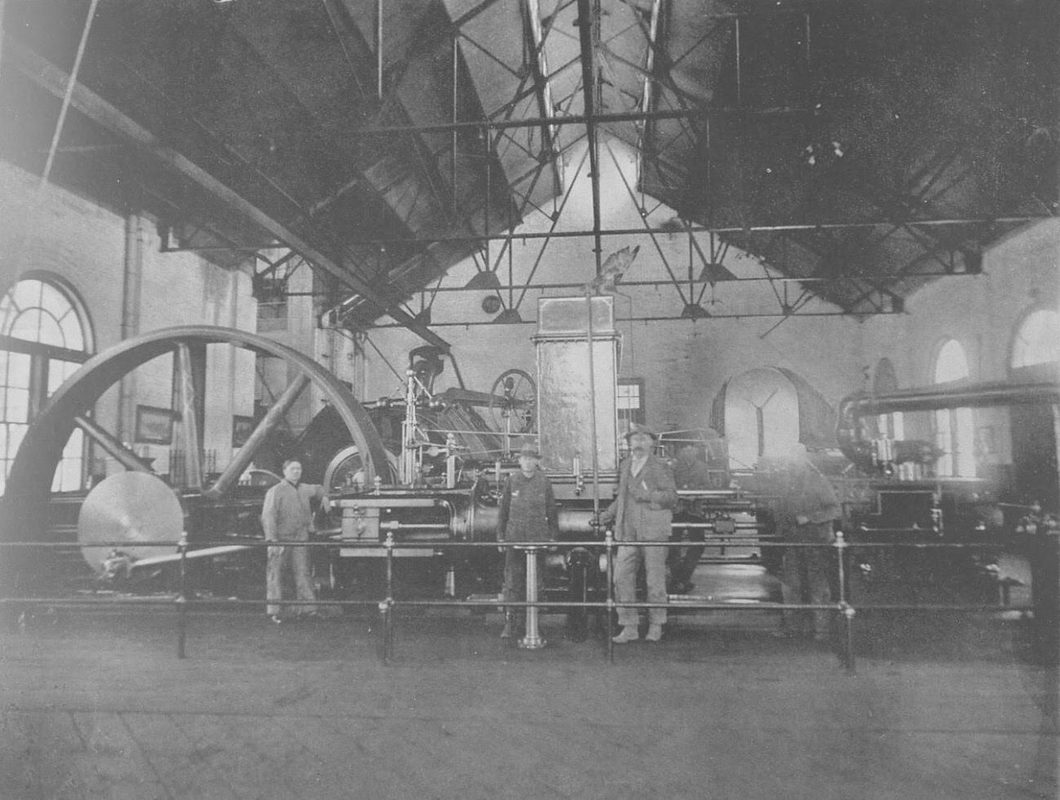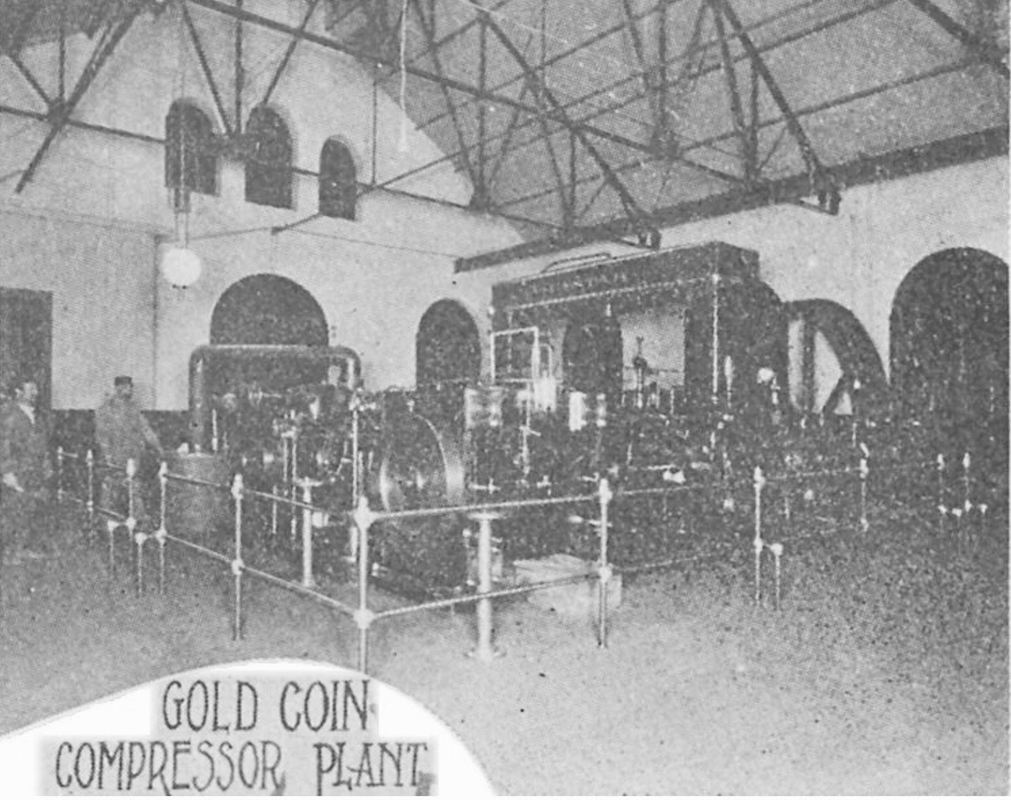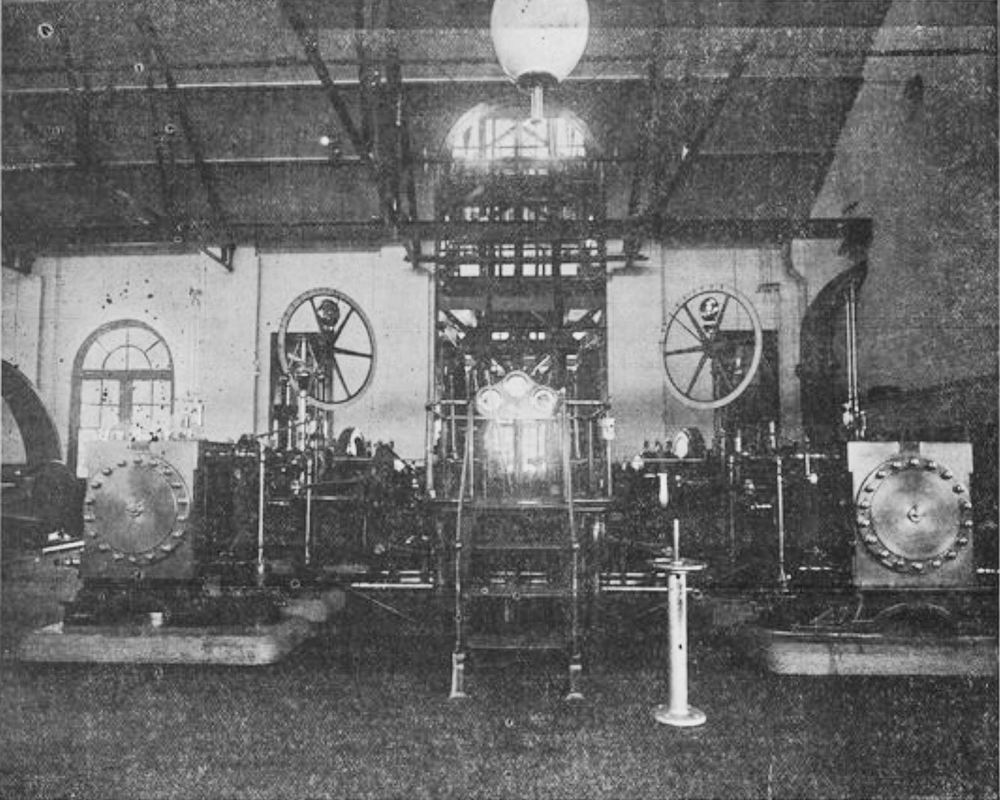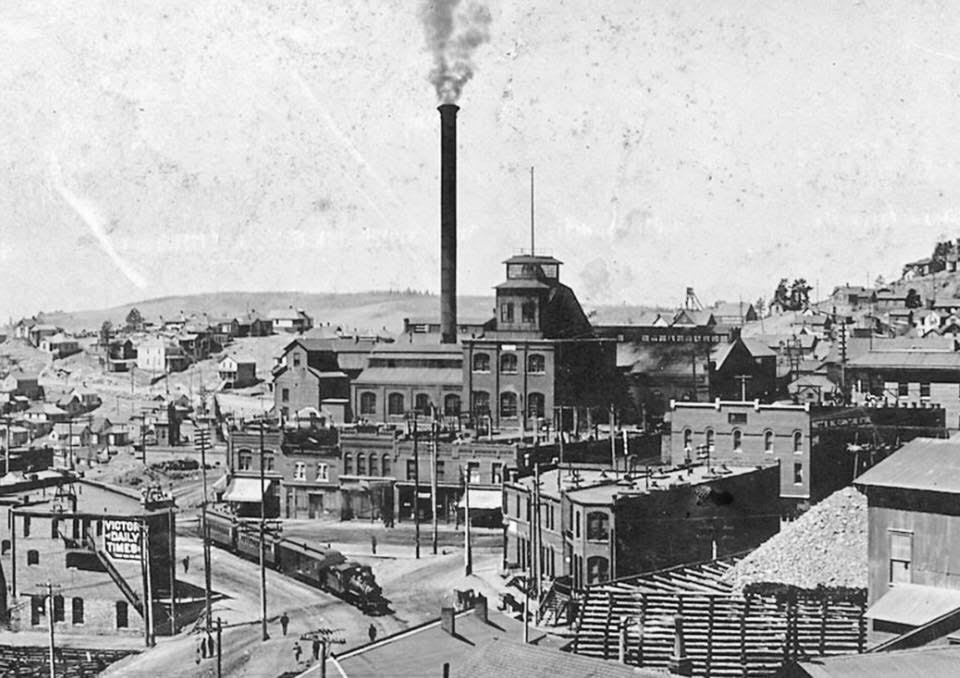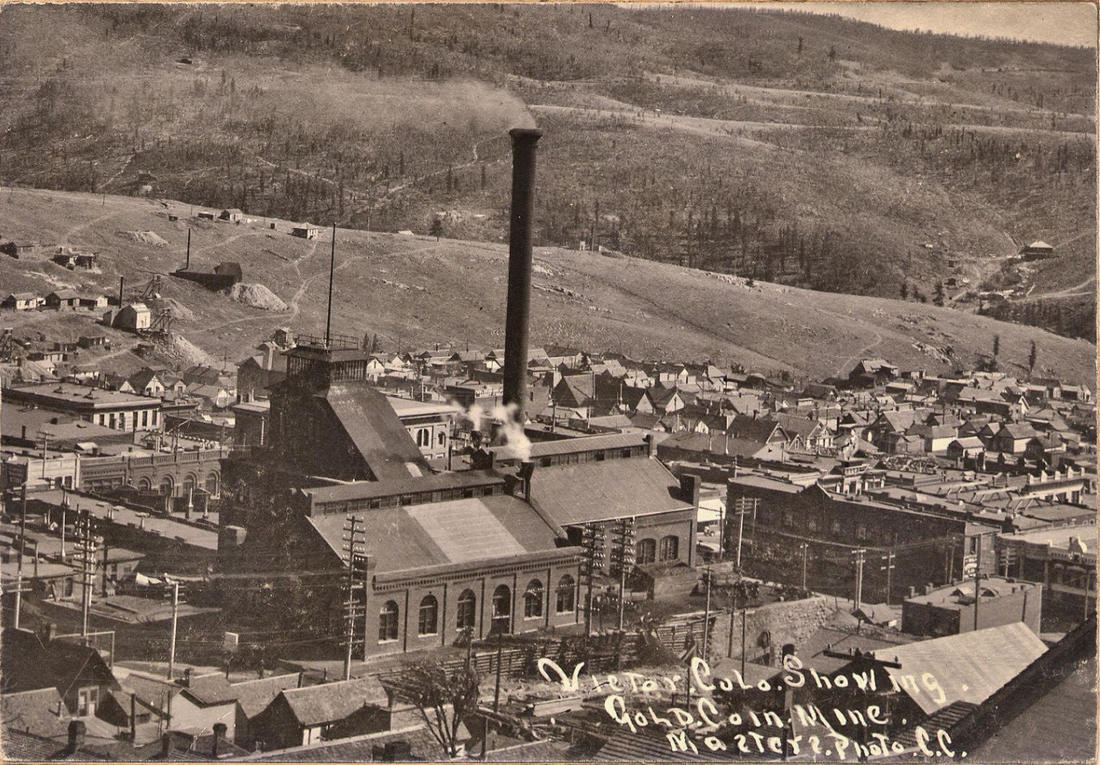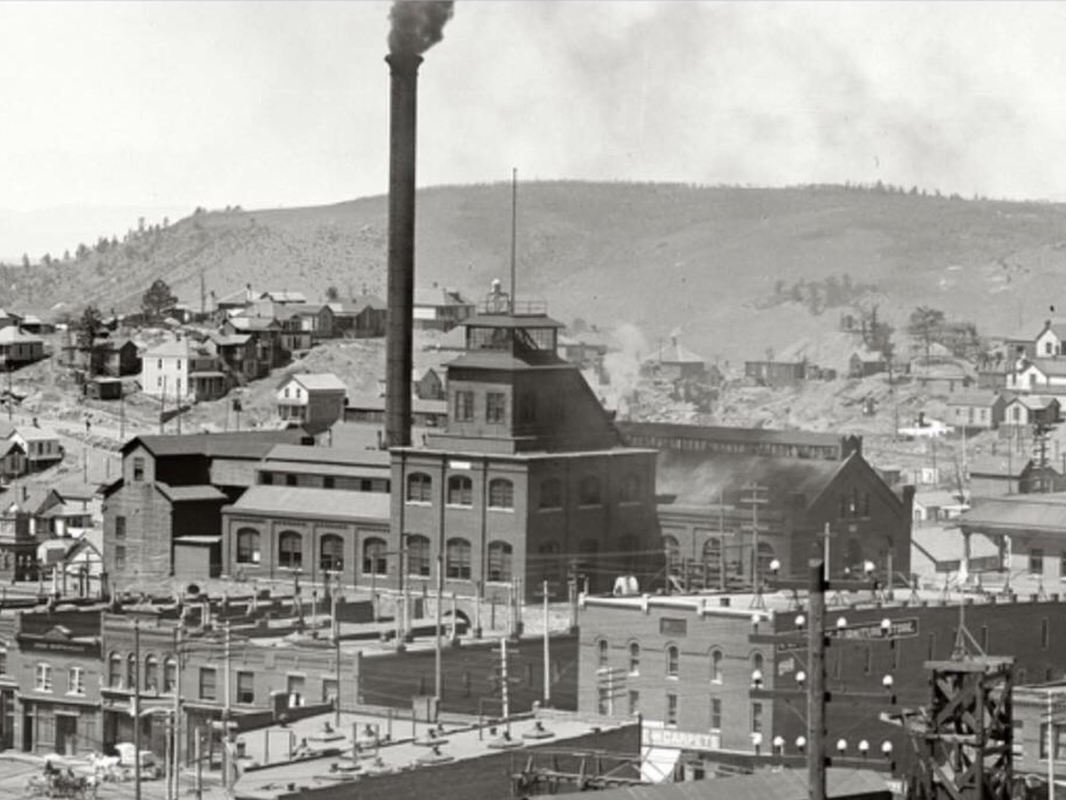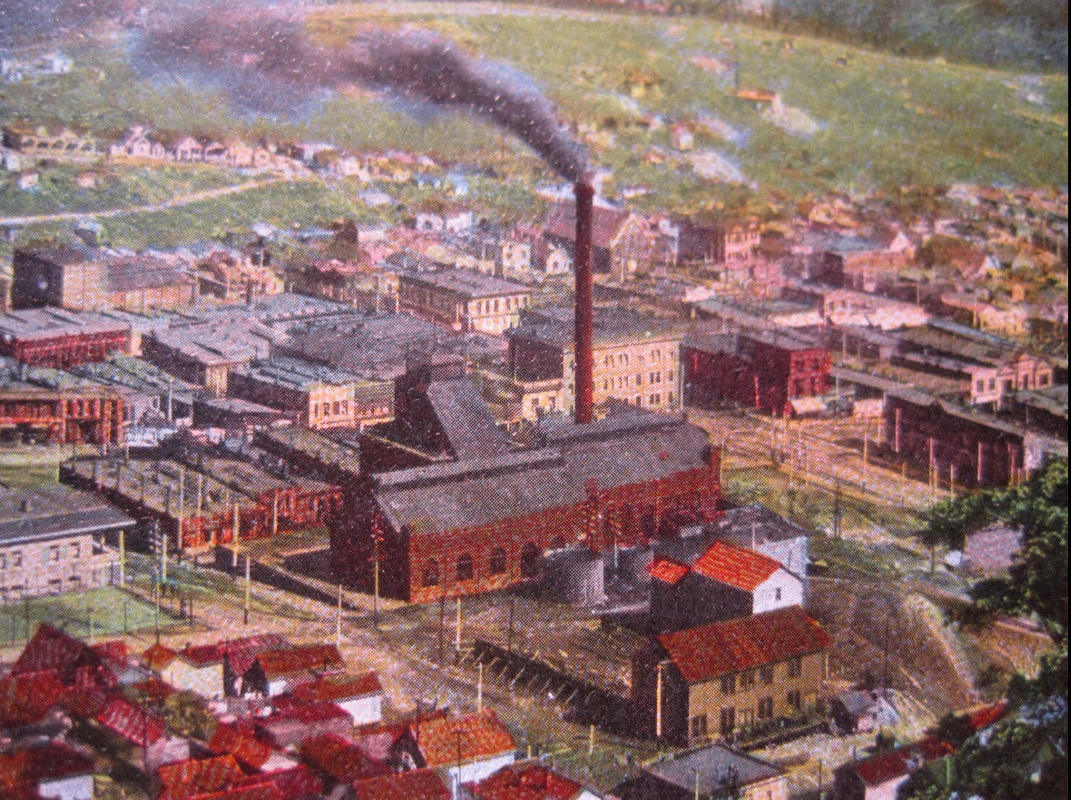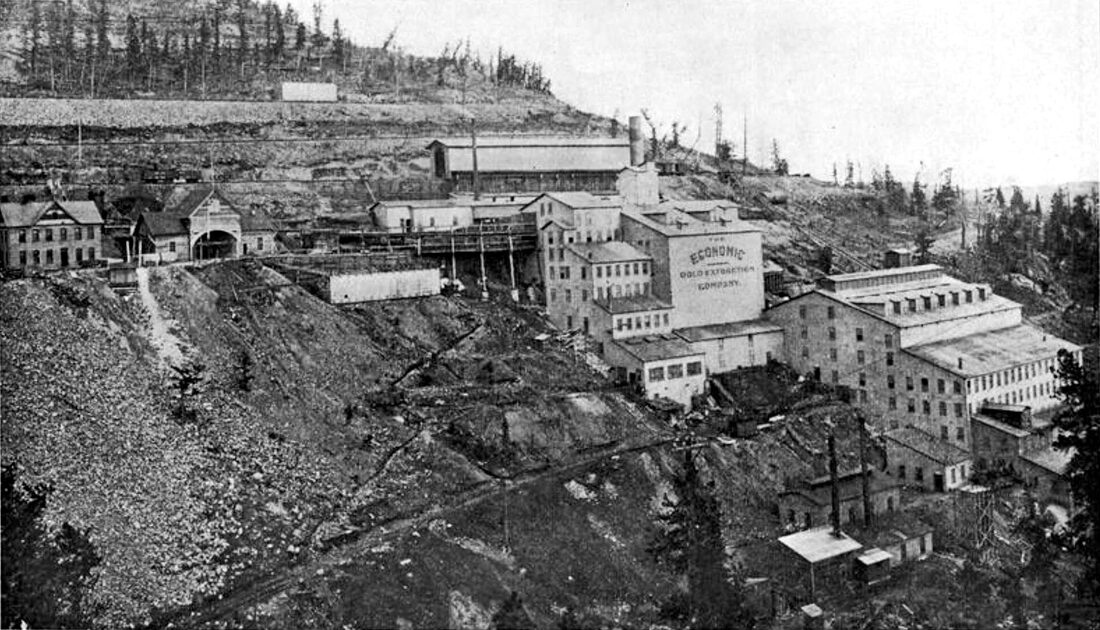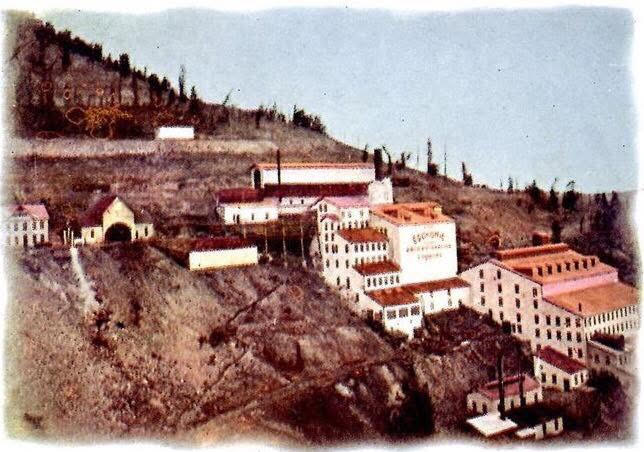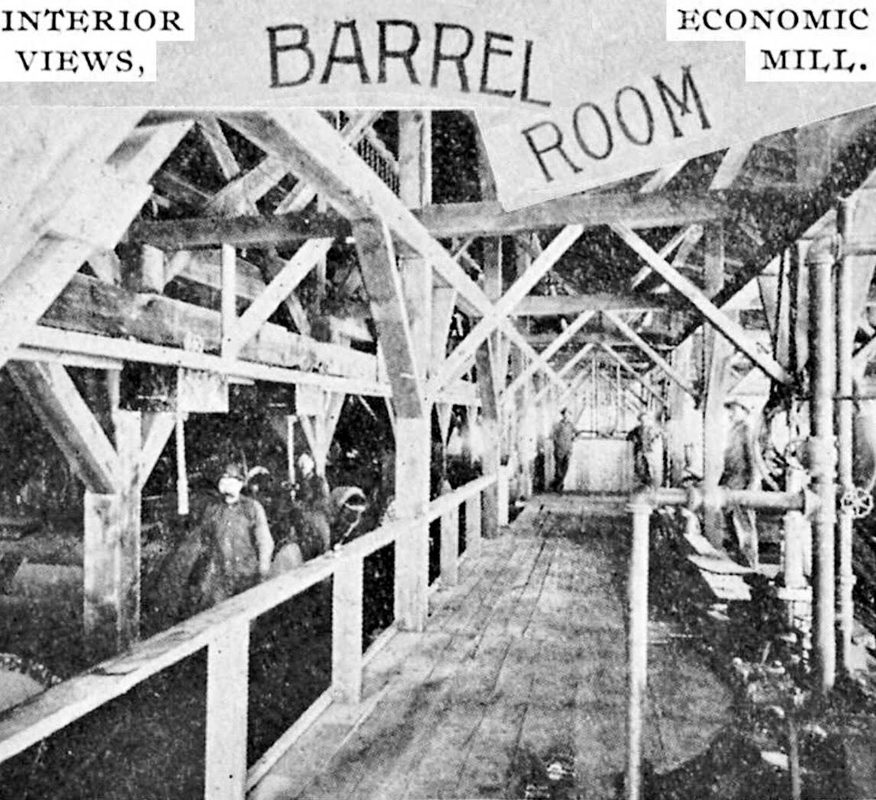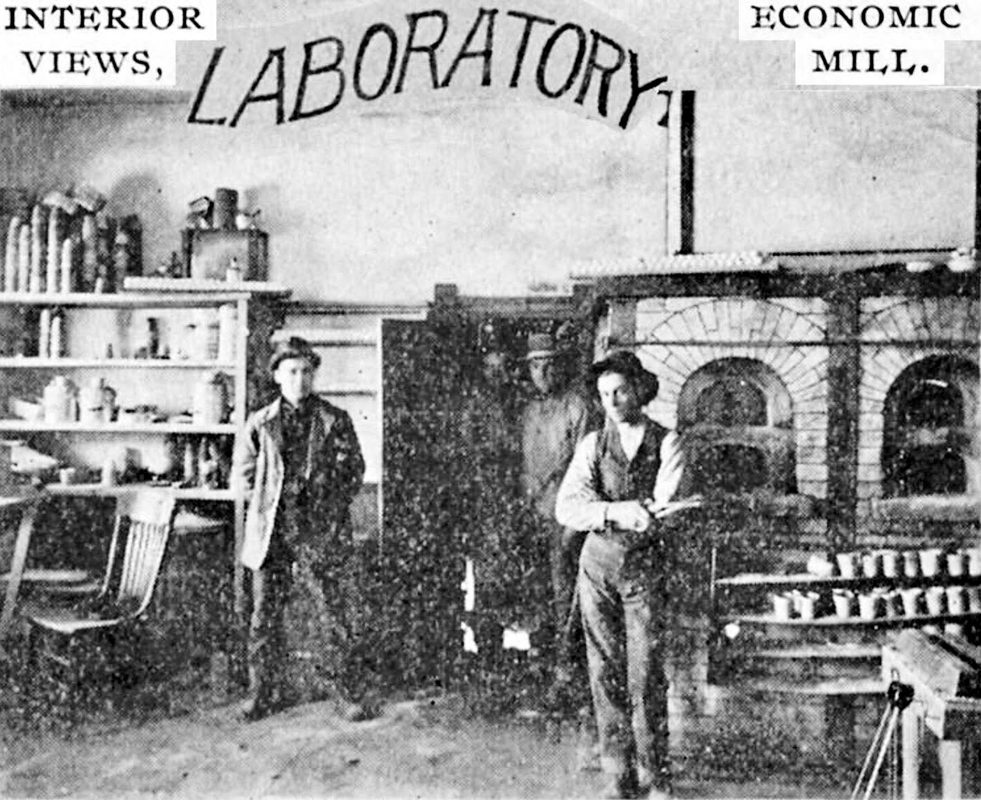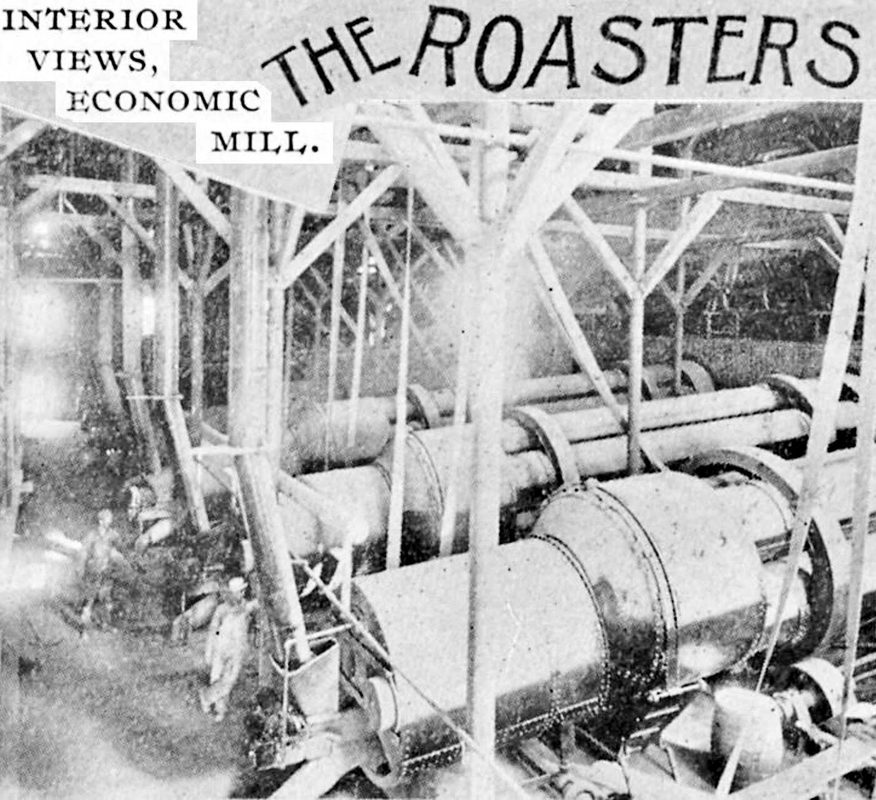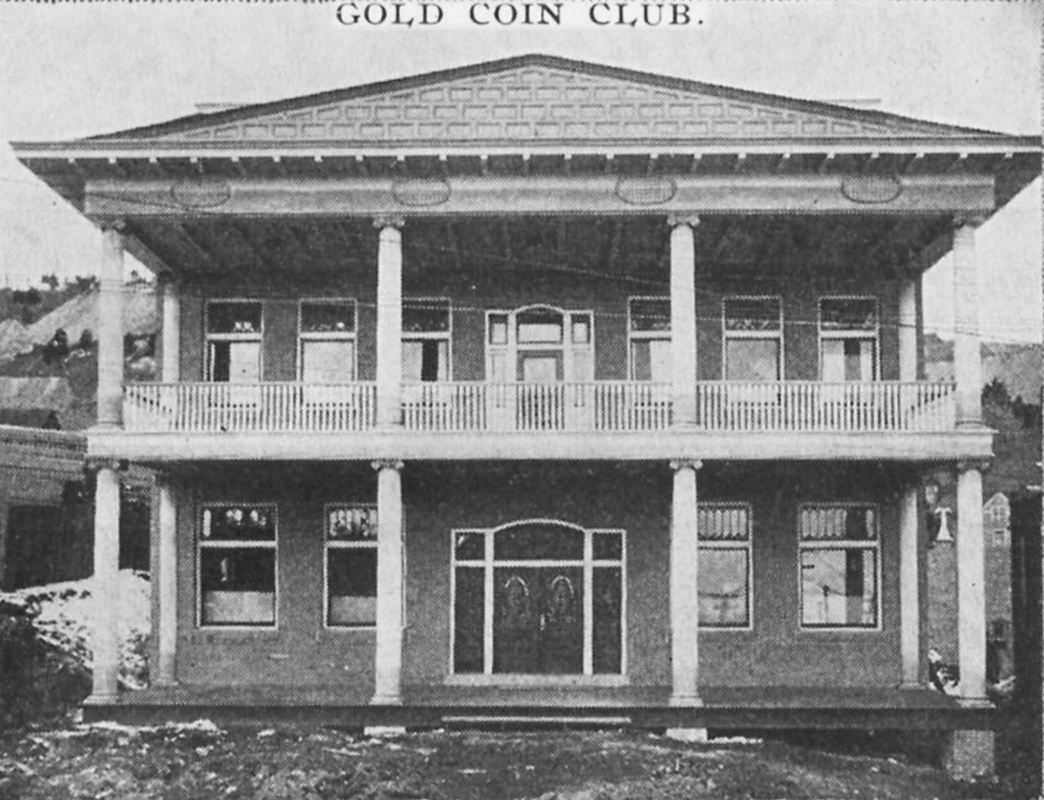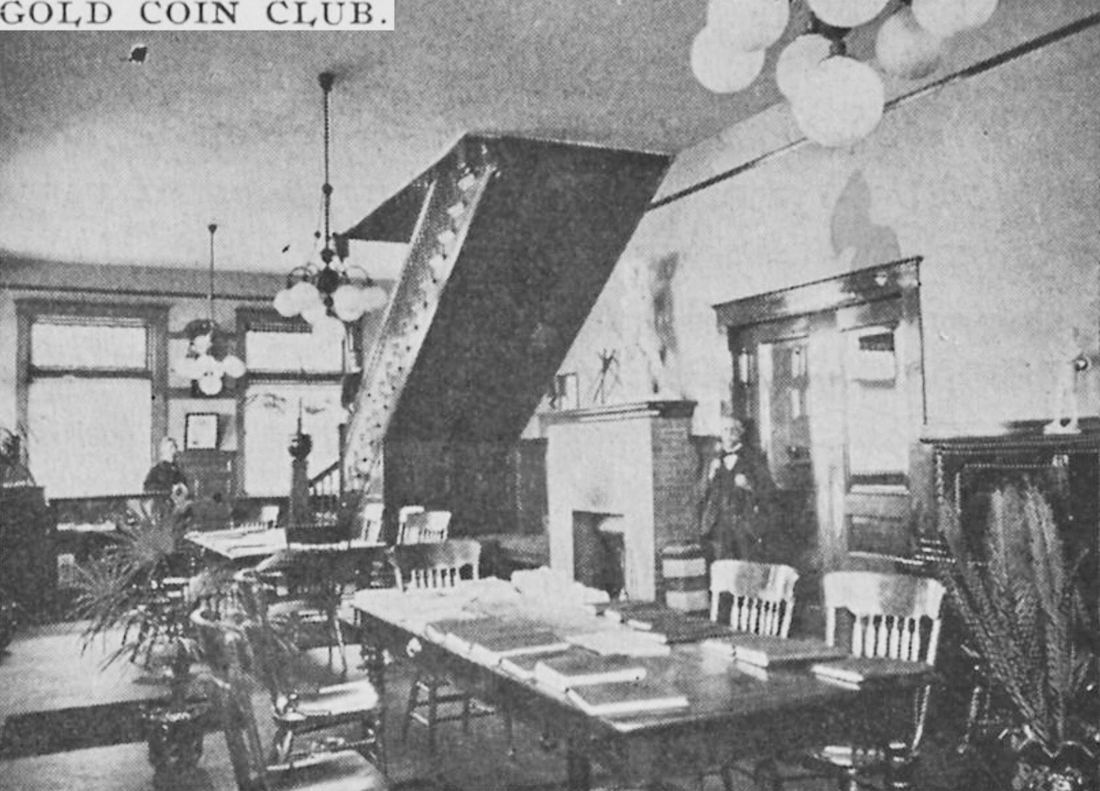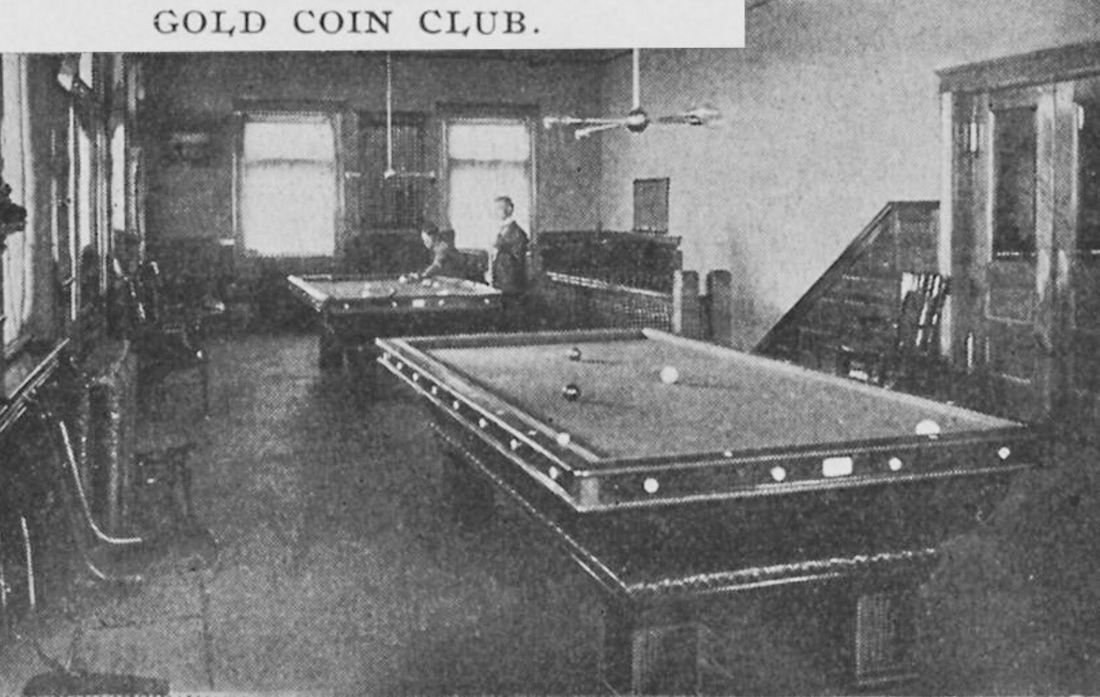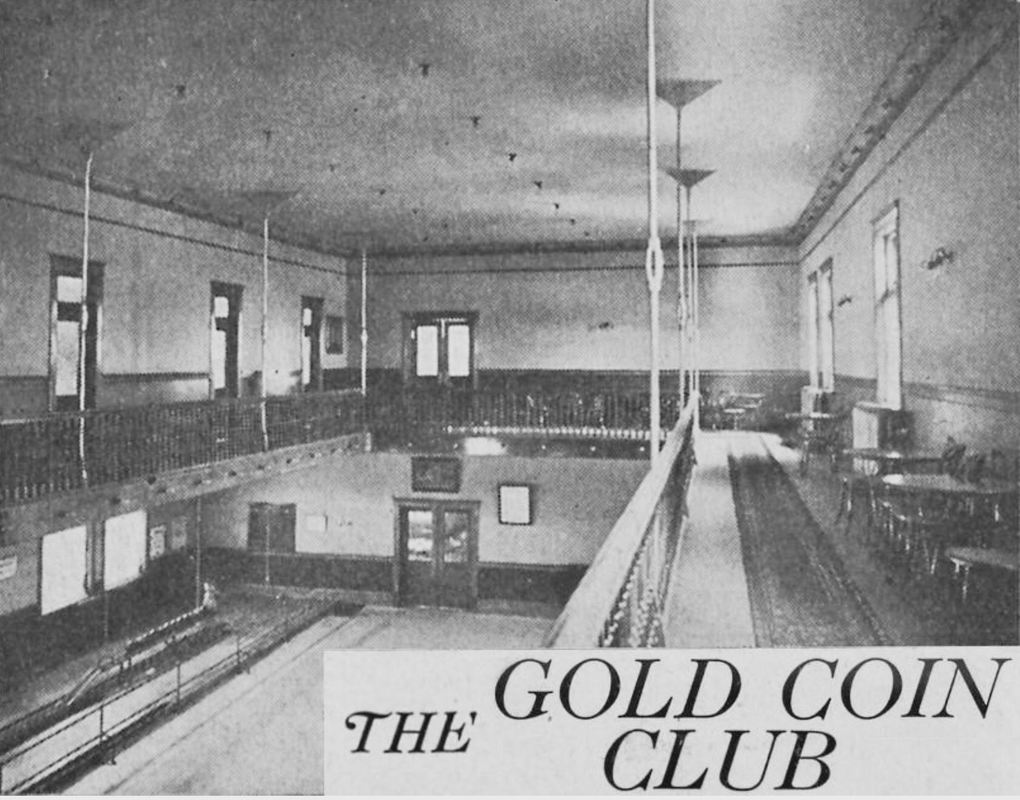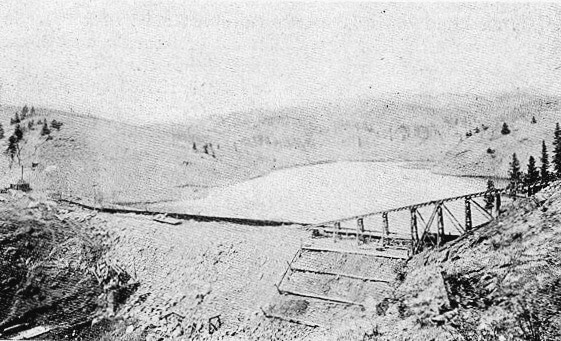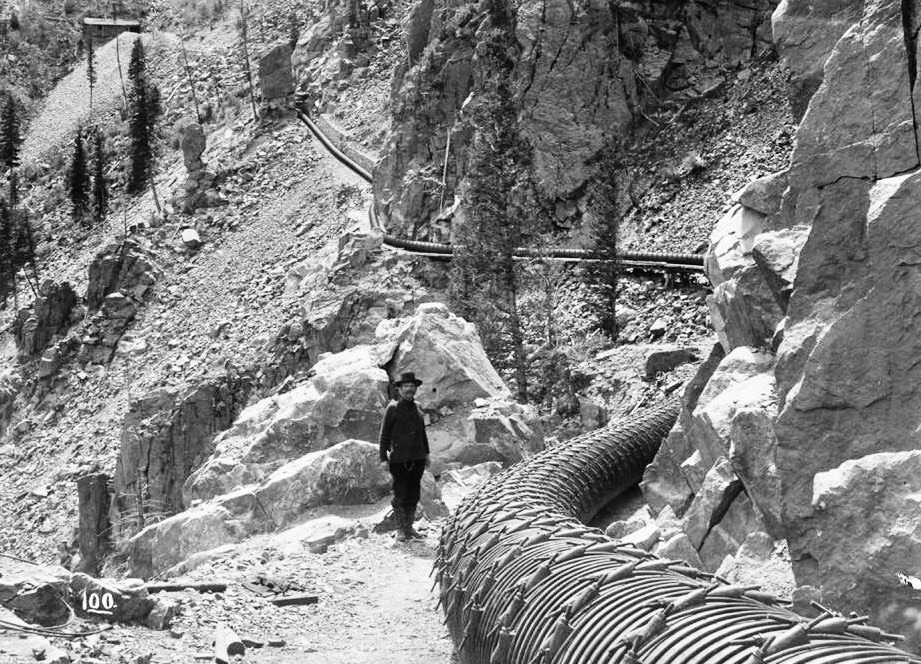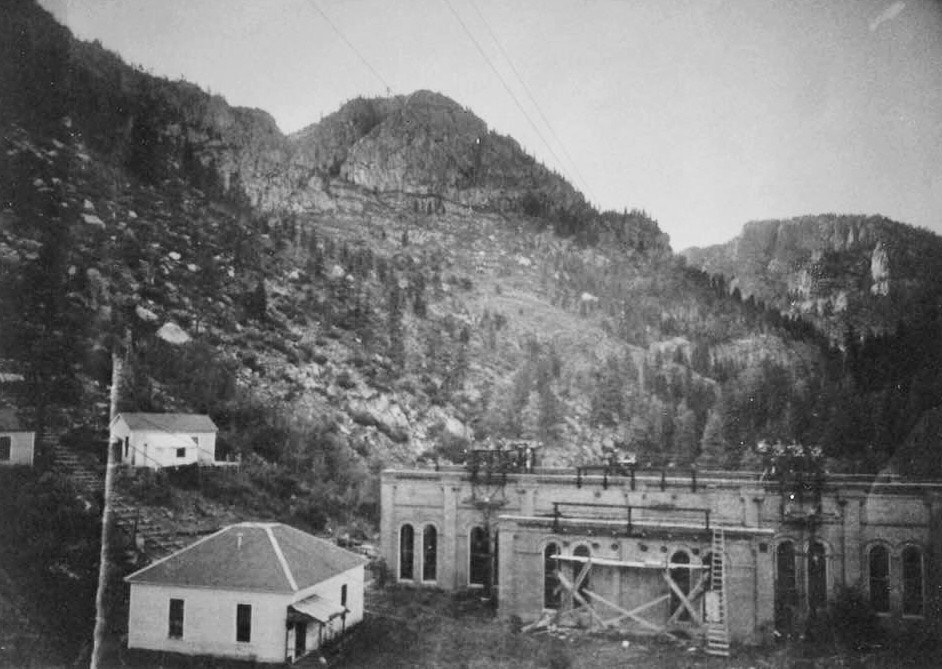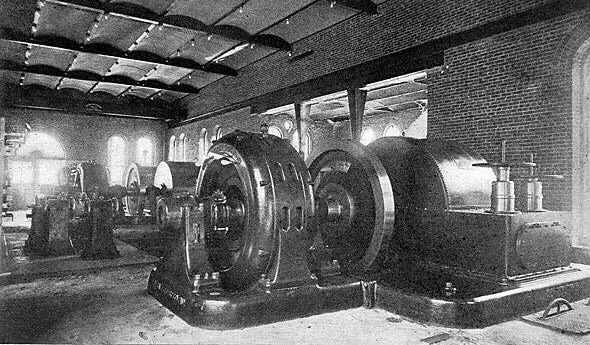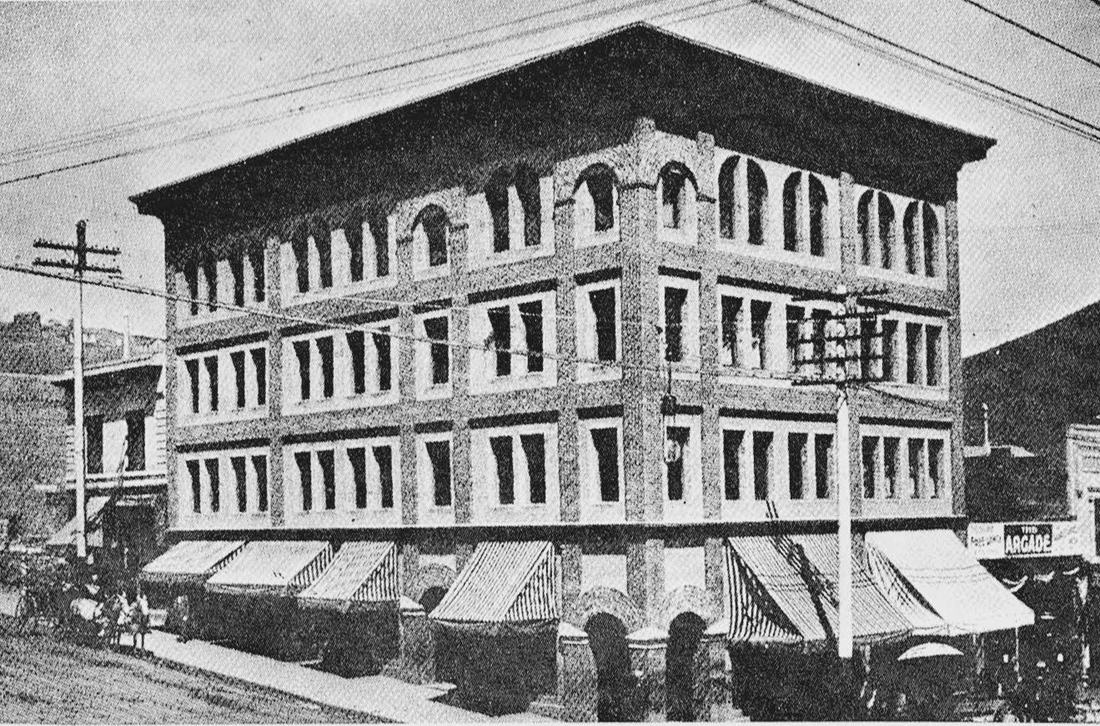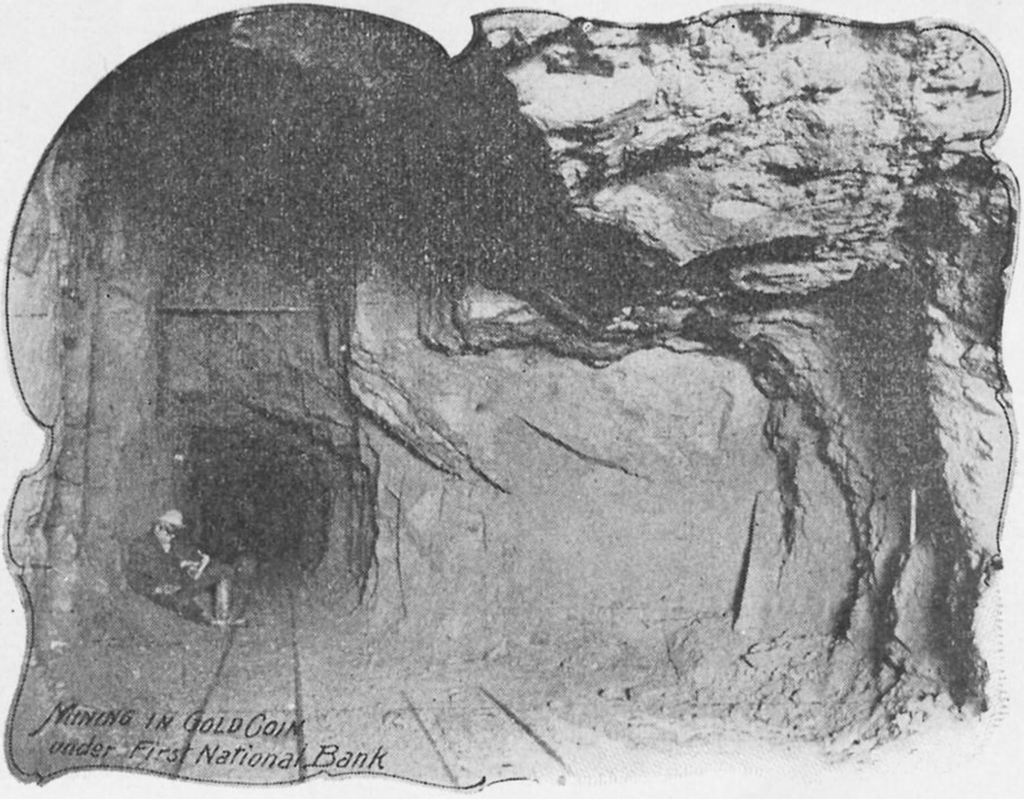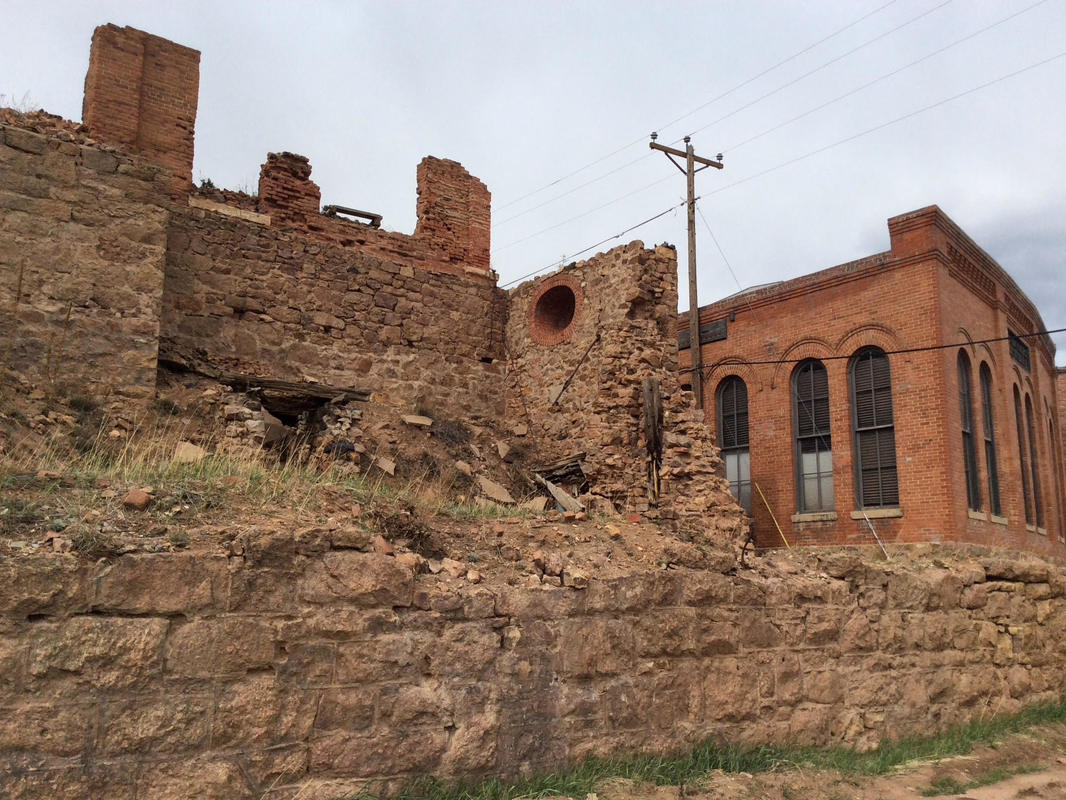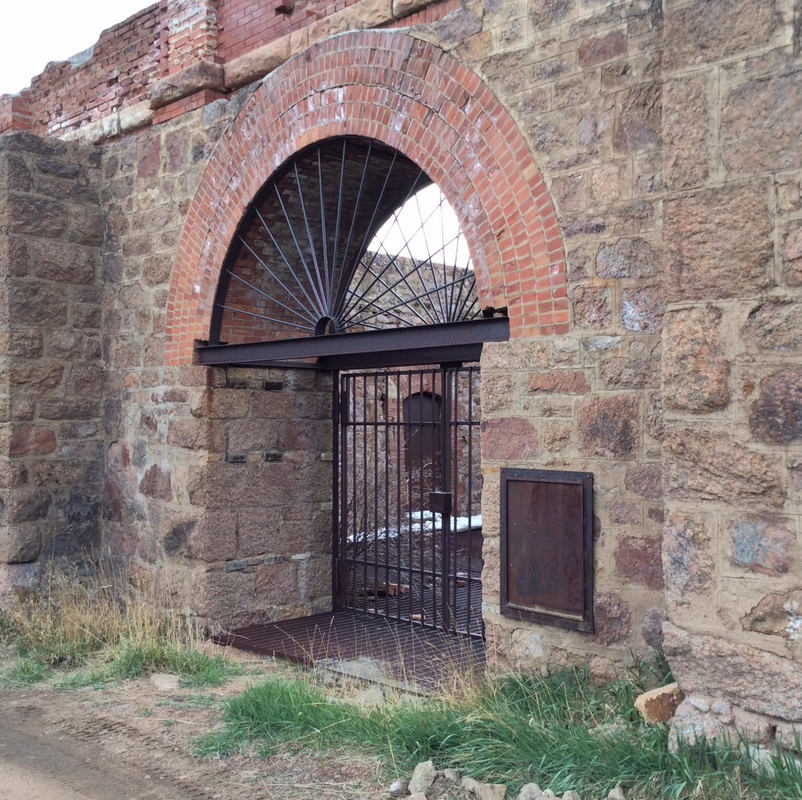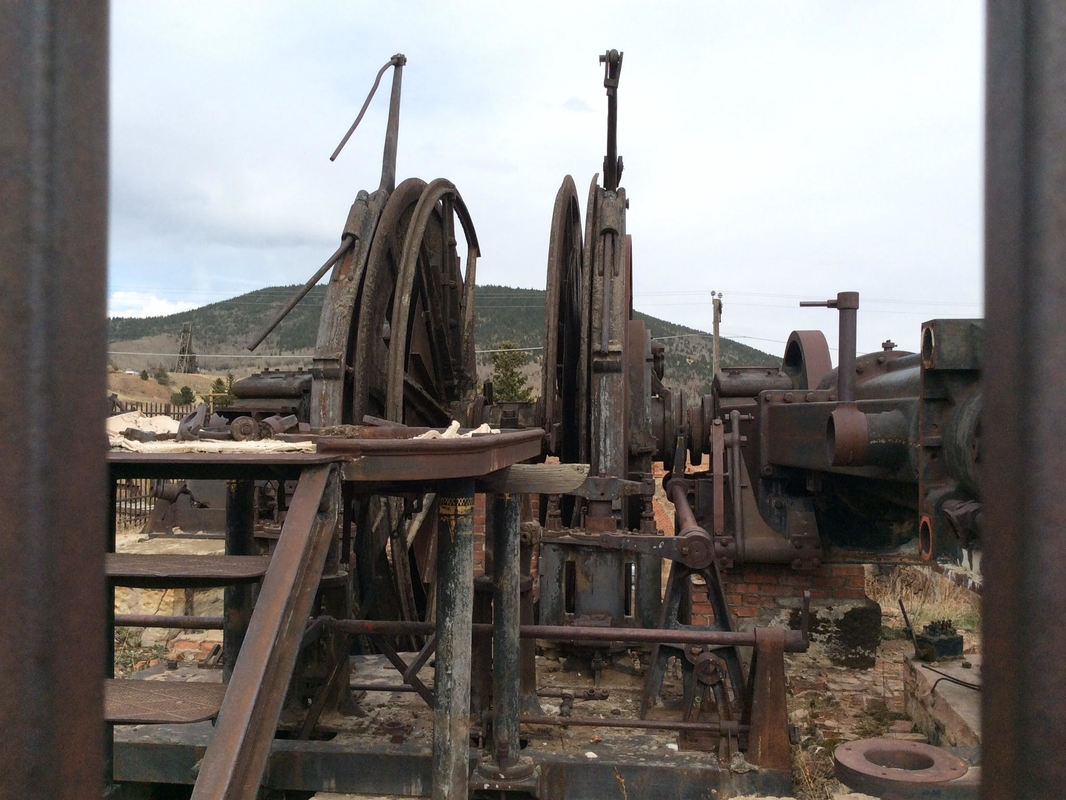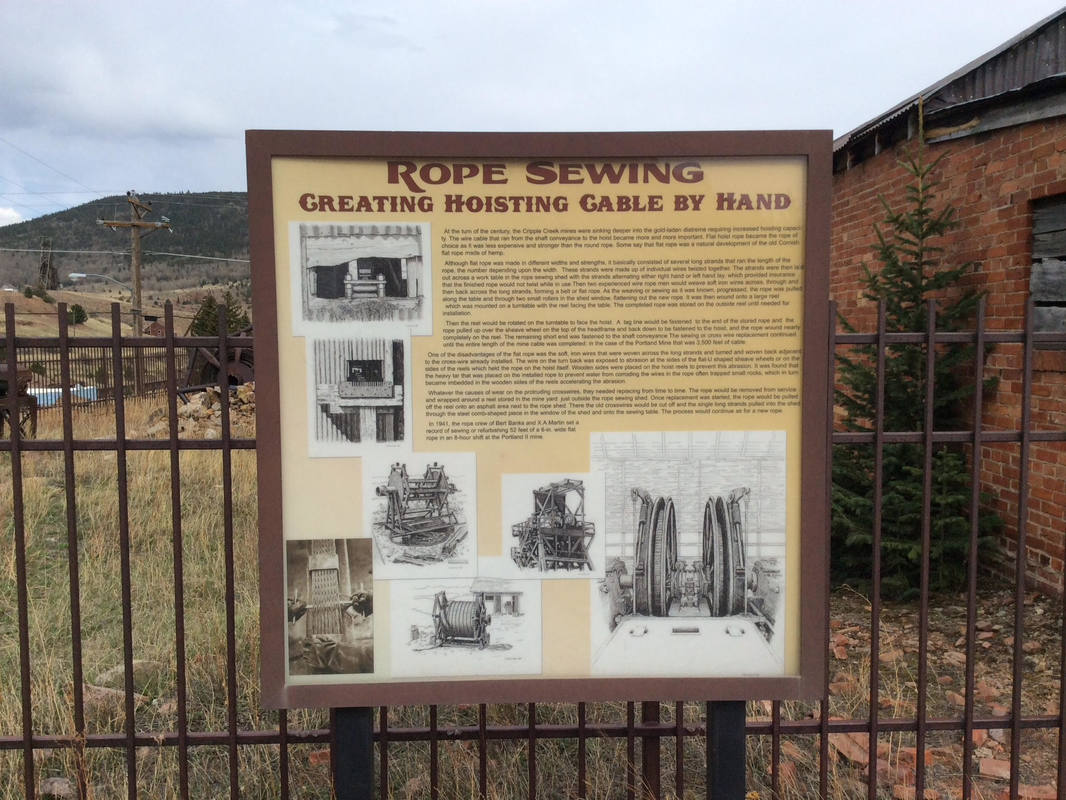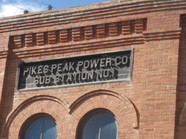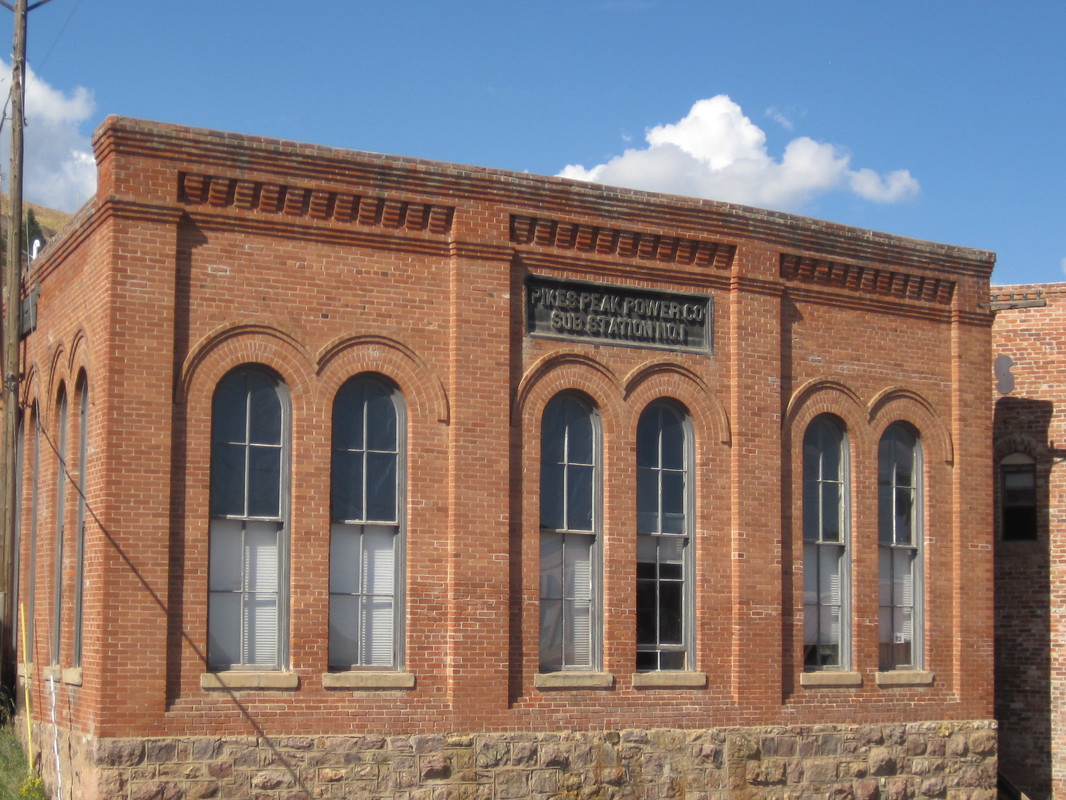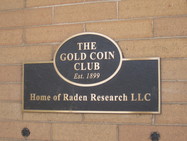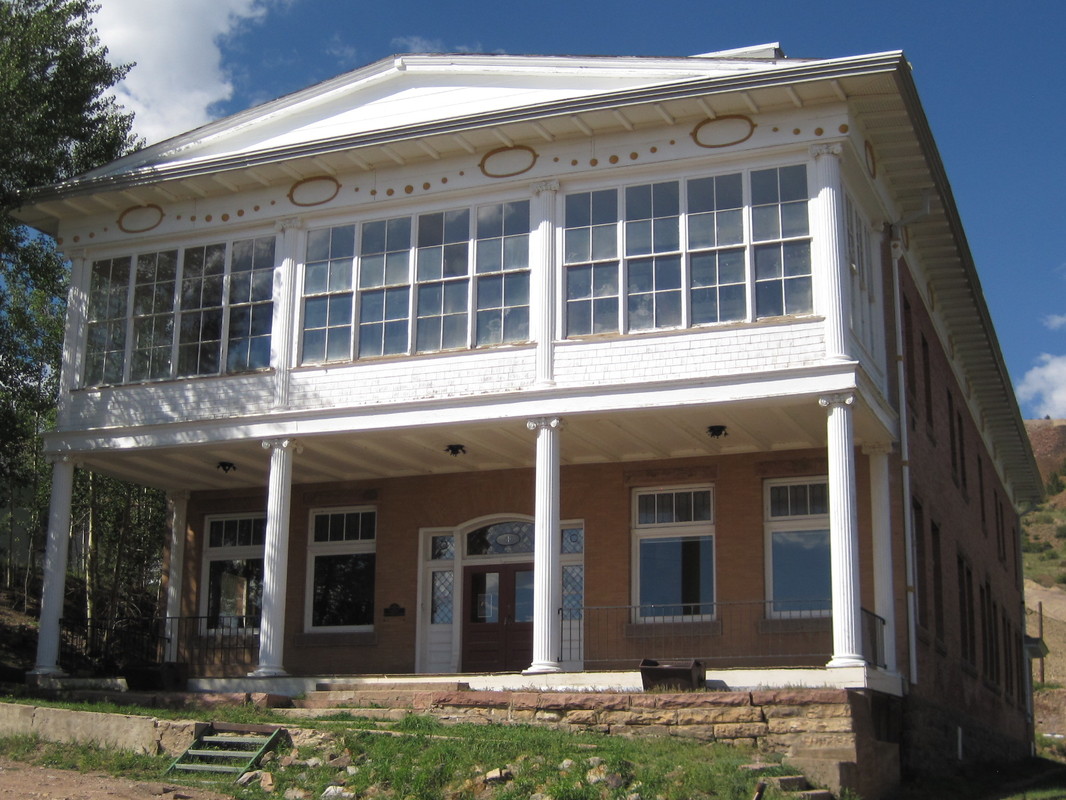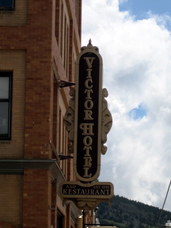Photo Gallery of Historic Underground Gold Mines Near Victor
Before the advent of large scale surface mining, the landscape of the Mining District between Victor and Cripple Creek was dotted with the relics and ruins of four to five hundred underground gold mines that employed thousands of miners all living within a short trolley ride or walking distance from the mines. This photo gallery provides a glimpse of what once was, and what still remains of the more prominent historic underground gold mines near Victor, Colorado.
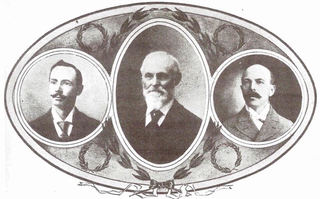 Frank, Warren and Harry Woods, Founders of Victor, from "Fortunes of a Decade," 1900. Photo contributed by Ron West.
Frank, Warren and Harry Woods, Founders of Victor, from "Fortunes of a Decade," 1900. Photo contributed by Ron West.
THE GOLD COIN MINE: Part of the Woods Family Empire
By La Jean Greeson, with contributions by Linda Irene Tingvik and edits by Margie King.
Warren, Frank and Harry Woods, the founders of Victor, Colorado, set out to build one of the finest, most elaborate hotels in the city. While digging the hotel foundation in March of 1894, Frank uncovered a twenty-inch-wide vein of gold ore, which was traced back to the Gold Coin Claim.
The Woods' Victor Hotel, shown below, was constructed on the NW corner of Victor Avenue & 4th Street. It was one of the most widely photographed buildings in the city. Hundreds of people perched on its balconies to watch the Independence and Labor Day Parades.
By La Jean Greeson, with contributions by Linda Irene Tingvik and edits by Margie King.
Warren, Frank and Harry Woods, the founders of Victor, Colorado, set out to build one of the finest, most elaborate hotels in the city. While digging the hotel foundation in March of 1894, Frank uncovered a twenty-inch-wide vein of gold ore, which was traced back to the Gold Coin Claim.
The Woods' Victor Hotel, shown below, was constructed on the NW corner of Victor Avenue & 4th Street. It was one of the most widely photographed buildings in the city. Hundreds of people perched on its balconies to watch the Independence and Labor Day Parades.
The Woods Investment Company, including Warren Woods, father and President, along with sons Frank Woods, Treasurer, and Harry Woods, Manager, paid $50,000 to lease the property where the mine was located. The Gold Coin Mining and Leasing Company incorporated November 19, 1895, and construction began on the Gold Coin Mine -- about a block behind the hotel.
It must be noted when lots were sold in Victor, they included only the surface ground. This prompted the lease. Upon completion (see photo below), the mine was an ambitious, successful operation and a major contender in the District. The Woods became millionaires and rightfully added the title of “Mine Owners” to their status as Realtors and City Developers.
It must be noted when lots were sold in Victor, they included only the surface ground. This prompted the lease. Upon completion (see photo below), the mine was an ambitious, successful operation and a major contender in the District. The Woods became millionaires and rightfully added the title of “Mine Owners” to their status as Realtors and City Developers.
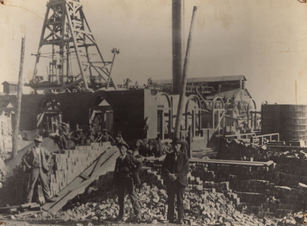 Rebuilding the Gold Coin Mine after the Great Victor Fire. Photo contributed by Linda Irene Tingvik,© CrippleCreekRailroads.Com.
Rebuilding the Gold Coin Mine after the Great Victor Fire. Photo contributed by Linda Irene Tingvik,© CrippleCreekRailroads.Com.
Fire Decimates Victor & Gold Coin Mine
During Victor’s Great Fire of August 21, 1899, the Gold Coin Mine surface structures burned, as did much of the downtown area of Victor. The fire charred timbers down to the 700-foot depth in the mine and the shaft was ruined to the 200-foot depth.
In her book, "Cripple Creek District: Last of Colorado’s Gold Booms," Jan MacKell Collins includes J.A. Small’s first-hand recounting of the Victor Fire’s impact on the Gold Coin Mine (where he worked) and the company-owned Victor Hotel. A letter written to his wife (who was out of town) recorded:
"Well dear, to night there is practically no Victor: the Cripple Creek fire [April 1896] has been duplicated and since 1:20 [PM] when the fire started until 6 o’clock everything north of Portland Ave. has been burned. The area being bounded on the east by the Washington School and on the west by the Methodist Church, everything north of the two points mentioned is a mass of smouldering ruins and as I write, the big lumber piles north of the [Florence & Cripple Creek Railroad] are burning fiercely."
"I stayed with the office until the whole front was smoking and by that time the flames had enveloped the cribbing at the rear. . . . We escaped through the ore house out onto the trestle, over the track. . . . I thought best to take no chances and immediately started to put books, papers, etc. into the vault, which you know, is just completed. We filled it chuck full and got all the furniture out and by then the hotel was in flames."
As soon as the fire was extinguished, recovery and rebuilding efforts commenced immediately. New buildings in the burned-out business district were reconstructed of fire resistant brick and stone as required by newly adopted building codes designed to prevent another fire from ravaging the city. Amazingly, most were completed within six to twelve months--including those at the Gold Coin Mine.
During Victor’s Great Fire of August 21, 1899, the Gold Coin Mine surface structures burned, as did much of the downtown area of Victor. The fire charred timbers down to the 700-foot depth in the mine and the shaft was ruined to the 200-foot depth.
In her book, "Cripple Creek District: Last of Colorado’s Gold Booms," Jan MacKell Collins includes J.A. Small’s first-hand recounting of the Victor Fire’s impact on the Gold Coin Mine (where he worked) and the company-owned Victor Hotel. A letter written to his wife (who was out of town) recorded:
"Well dear, to night there is practically no Victor: the Cripple Creek fire [April 1896] has been duplicated and since 1:20 [PM] when the fire started until 6 o’clock everything north of Portland Ave. has been burned. The area being bounded on the east by the Washington School and on the west by the Methodist Church, everything north of the two points mentioned is a mass of smouldering ruins and as I write, the big lumber piles north of the [Florence & Cripple Creek Railroad] are burning fiercely."
"I stayed with the office until the whole front was smoking and by that time the flames had enveloped the cribbing at the rear. . . . We escaped through the ore house out onto the trestle, over the track. . . . I thought best to take no chances and immediately started to put books, papers, etc. into the vault, which you know, is just completed. We filled it chuck full and got all the furniture out and by then the hotel was in flames."
As soon as the fire was extinguished, recovery and rebuilding efforts commenced immediately. New buildings in the burned-out business district were reconstructed of fire resistant brick and stone as required by newly adopted building codes designed to prevent another fire from ravaging the city. Amazingly, most were completed within six to twelve months--including those at the Gold Coin Mine.
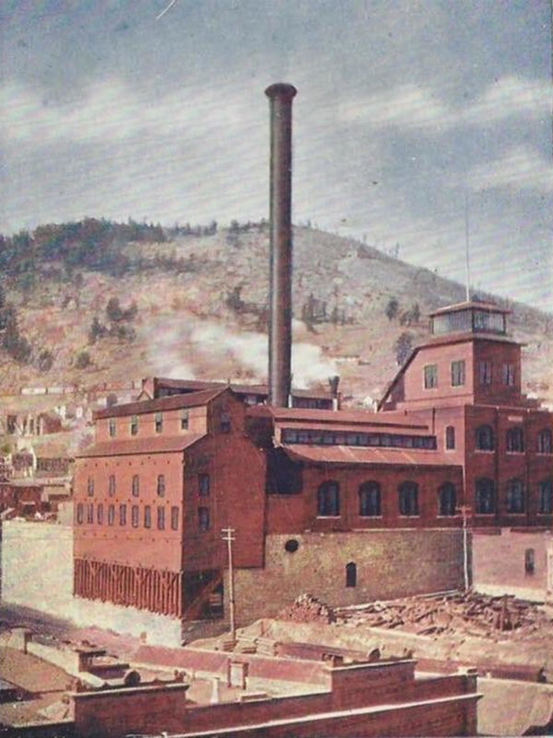 Gold Coin Mine, rebuilt after the Great Fire. Rubble at lower right is the location where the Pikes Peak Power Building will soon be constructed. Hand tinted photo contributed by La Jean Greeson.
Gold Coin Mine, rebuilt after the Great Fire. Rubble at lower right is the location where the Pikes Peak Power Building will soon be constructed. Hand tinted photo contributed by La Jean Greeson.
Gold Coin Mine Rebuilt
The Woods embraced the new fire prevention measures by sparing no expense in rebuilding the Gold Coin Mine. The shaft house around the gallows frame, the hoist house, and compressor plant were constructed of ornate pressed brick and steel, and the windows were made of stained glass.
The construction price was $250,000—a fortune in that era. The new structures were considered the finest of their kind in the District, a true mining show place.
In "The Cripple Creek Mining District, 1900 – 1901," A. C. Bray describes the newly rebuilt Gold Coin Mine facilities:
"To get an idea of the size of the buildings, one must carry a scale 72 feet in his mind’s eye, for that is the distance from the stone abutment, which forms a retaining wall for the first story of the building to the peak of the cupola over the gallows frame. . . . The buildings look like a well put up cotton or woolen mill of the east, for the entire structure is of brick and steel and is much out of conformity with one’s popular idea of a rough and ready mining camp. . . . [T]he main feature of the plant is of course the shaft house, which is the central portion of the structure. It is 40 feet square and 75 feet high. . . . The engine room is the long arm of the building beyond the shaft house, while the other portions of the building are given over to the boiler rooms, from the roof of which the great stack of the mine rises to the height of 145 feet. . . . [T]he compressors … are located in the engine room and extend across the entire width of the room, 53 feet. . . . Seven hundred and fifty-eight horsepower is needed to operate the great hoist, which can whizz a double deck cage 1,500 feet in 60 seconds. . . . The four great boilers located in the boiler rooms are Titans of strength and generate the steam used in running the many parts of the plant."
The Woods embraced the new fire prevention measures by sparing no expense in rebuilding the Gold Coin Mine. The shaft house around the gallows frame, the hoist house, and compressor plant were constructed of ornate pressed brick and steel, and the windows were made of stained glass.
The construction price was $250,000—a fortune in that era. The new structures were considered the finest of their kind in the District, a true mining show place.
In "The Cripple Creek Mining District, 1900 – 1901," A. C. Bray describes the newly rebuilt Gold Coin Mine facilities:
"To get an idea of the size of the buildings, one must carry a scale 72 feet in his mind’s eye, for that is the distance from the stone abutment, which forms a retaining wall for the first story of the building to the peak of the cupola over the gallows frame. . . . The buildings look like a well put up cotton or woolen mill of the east, for the entire structure is of brick and steel and is much out of conformity with one’s popular idea of a rough and ready mining camp. . . . [T]he main feature of the plant is of course the shaft house, which is the central portion of the structure. It is 40 feet square and 75 feet high. . . . The engine room is the long arm of the building beyond the shaft house, while the other portions of the building are given over to the boiler rooms, from the roof of which the great stack of the mine rises to the height of 145 feet. . . . [T]he compressors … are located in the engine room and extend across the entire width of the room, 53 feet. . . . Seven hundred and fifty-eight horsepower is needed to operate the great hoist, which can whizz a double deck cage 1,500 feet in 60 seconds. . . . The four great boilers located in the boiler rooms are Titans of strength and generate the steam used in running the many parts of the plant."
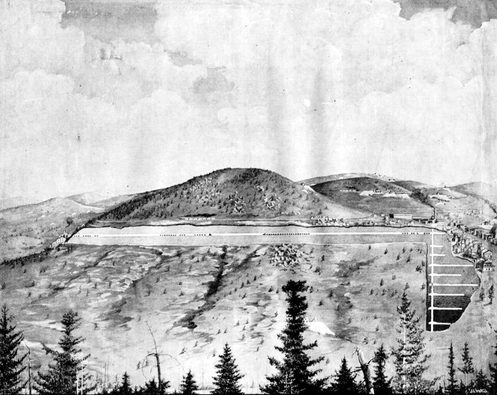 Artist rendering of the Gold Coin Mine workings under the streets of Victor and the Columbine-Victor Tunnel under Squaw Mountain. An electric locomotive moved between the Economic Extraction Plant (left) and the mine (right) through Squaw Mountain. From “Gold Fields of Cripple Creek–Pan-American Exposition,” 1901. Photo contributed by Linda Irene Tingvik, © CrippleCreekRailroads.Com.
Artist rendering of the Gold Coin Mine workings under the streets of Victor and the Columbine-Victor Tunnel under Squaw Mountain. An electric locomotive moved between the Economic Extraction Plant (left) and the mine (right) through Squaw Mountain. From “Gold Fields of Cripple Creek–Pan-American Exposition,” 1901. Photo contributed by Linda Irene Tingvik, © CrippleCreekRailroads.Com.
Columbine-Victor Tunnel
Since the hoist house for removing ore and waste rock from various levels of the Gold Coin Mine was located in the heart of Victor, the Columbine-Victor Tunnel was driven about three-fourths of a mile in length through Squaw Mountain. This was to facilitate disposal of waste rock and connect with an ore processing mill that was eventually built on the west slope of Squaw Mountain in Eclipse Gulch.
The tunnel helped keep the downtown area clear of waste rock and ore awaiting shipping and processing. Initially mules were used to transport ore and waste rock.
In March of 1901, tracks were laid in the tunnel for an electric mine locomotive that replaced the animals. The engine traveled on 18-inch tracks, and was powered through a trolley pole with a wheel at the end. The locomotive ran along a wire hanging down from the roof at Level One of the mine.
Since the hoist house for removing ore and waste rock from various levels of the Gold Coin Mine was located in the heart of Victor, the Columbine-Victor Tunnel was driven about three-fourths of a mile in length through Squaw Mountain. This was to facilitate disposal of waste rock and connect with an ore processing mill that was eventually built on the west slope of Squaw Mountain in Eclipse Gulch.
The tunnel helped keep the downtown area clear of waste rock and ore awaiting shipping and processing. Initially mules were used to transport ore and waste rock.
In March of 1901, tracks were laid in the tunnel for an electric mine locomotive that replaced the animals. The engine traveled on 18-inch tracks, and was powered through a trolley pole with a wheel at the end. The locomotive ran along a wire hanging down from the roof at Level One of the mine.
Economic Gold Extraction Mill
Rather than shipping ore for processing to plants at a lower altitude, the Woods Investment Company constructed the Economic Gold Extraction Mill. Photos below show the mill facilities cascading down the west slope of Squaw Mountain in Eclipse Gulch. The new chlorination mill, which opened in late 1899 using the best technology available at the time, processed ore from the Gold Coin as well as other mines.
Rather than shipping ore for processing to plants at a lower altitude, the Woods Investment Company constructed the Economic Gold Extraction Mill. Photos below show the mill facilities cascading down the west slope of Squaw Mountain in Eclipse Gulch. The new chlorination mill, which opened in late 1899 using the best technology available at the time, processed ore from the Gold Coin as well as other mines.
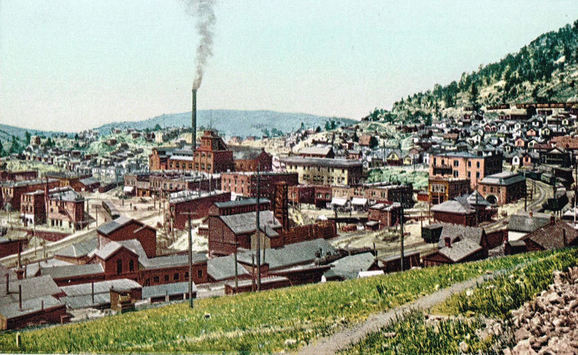 Victor view prominently featuring Gold Coin Mine & Club, about 1902. Hand tinted photo from La Jean Greeson.
Victor view prominently featuring Gold Coin Mine & Club, about 1902. Hand tinted photo from La Jean Greeson.
In 1901, Frank Woods and the Woods Investment Company sponsored a booth in the Mining Building at the Pan-American Exposition in Buffalo, New York. The goal was to raise money from investors to expand the Woods empire. The Exposition ran from May first through November second. Their promotional booklet, "Gold Fields of Cripple Creek – Pan-American Exposition, Buffalo, New York," contained information about all the Woods properties and featured many of the photos shown here.
At that time, the Gold Coin Mine employed 300 men with an annual payroll of $350,000. It encompassed over three miles of levels and drifts, and had reached 1,100 feet in depth, working towards a goal of 1,400. The “mine (was) lighted by electricity and equipped with a pumping plant, diamond drilling apparatus, a twenty-four drill Rand air compressor, and an electric signal system.”
At that time, the Gold Coin Mine employed 300 men with an annual payroll of $350,000. It encompassed over three miles of levels and drifts, and had reached 1,100 feet in depth, working towards a goal of 1,400. The “mine (was) lighted by electricity and equipped with a pumping plant, diamond drilling apparatus, a twenty-four drill Rand air compressor, and an electric signal system.”
Gold Coin Club & Pinnacle Park
Most of the millionaires to come out of the Cripple Creek Mining District lived in Colorado Springs, where much of their wealth from the District benefited their city of residence. The Woods family was the exception when it came to their loyal workers. While they lived in Colorado Springs, the family respected the place where they earned their fortune and invested back in that community. The Gold Coin Club and Pinnacle Park are two examples.
The Gold Coin Club, patterned after the New York City Athletic Club, was constructed by the Woods Investment Company as a social and recreational facility for their employees. Anyone who had worked 60 days for the company could belong. The first club building was finished just in time to be swept away by the Great Victor Fire. It, too, was immediately rebuilt in brick at a cost of $50,000 and included a ballroom, gymnasium and baths, bowling lanes, outdoor tennis courts, billiards, pool and game room, 700-volume library, and dining rooms. There were ten sleeping rooms for let to members. The club even had its own thirty-piece band to entertain guests and represent the company at local parades and other social events. [Mines & Minerals]
Most of the millionaires to come out of the Cripple Creek Mining District lived in Colorado Springs, where much of their wealth from the District benefited their city of residence. The Woods family was the exception when it came to their loyal workers. While they lived in Colorado Springs, the family respected the place where they earned their fortune and invested back in that community. The Gold Coin Club and Pinnacle Park are two examples.
The Gold Coin Club, patterned after the New York City Athletic Club, was constructed by the Woods Investment Company as a social and recreational facility for their employees. Anyone who had worked 60 days for the company could belong. The first club building was finished just in time to be swept away by the Great Victor Fire. It, too, was immediately rebuilt in brick at a cost of $50,000 and included a ballroom, gymnasium and baths, bowling lanes, outdoor tennis courts, billiards, pool and game room, 700-volume library, and dining rooms. There were ten sleeping rooms for let to members. The club even had its own thirty-piece band to entertain guests and represent the company at local parades and other social events. [Mines & Minerals]
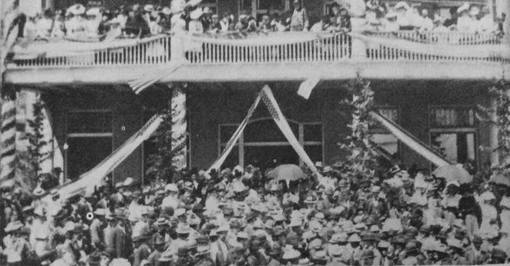 Vice President Teddy Roosevelt at Gold Coin Club, 1901. Photo from “Pay Dirt” by Rufus L. Porter.
Vice President Teddy Roosevelt at Gold Coin Club, 1901. Photo from “Pay Dirt” by Rufus L. Porter.
On August 4, 1901 Teddy Roosevelt, Vice-President of the United States, visited Victor. On this second trip to the District, he traveled via the newly completed Colorado Springs and Cripple Creek Railroad (known also as the Short Line) which was constructed with investment by the Woods family and other mine owners. Roosevelt was the guest of many of the most prominent mine owners in the District, including the Woods family.
Lunch for the Vice President was an elaborate affair at the Gold Coin Club. After lunch, Teddy was given a tour of the underground workings of the Gold Coin Mine where he personally mined $500 worth of gold ore that was sacked and presented to him as a gift.
Lunch for the Vice President was an elaborate affair at the Gold Coin Club. After lunch, Teddy was given a tour of the underground workings of the Gold Coin Mine where he personally mined $500 worth of gold ore that was sacked and presented to him as a gift.
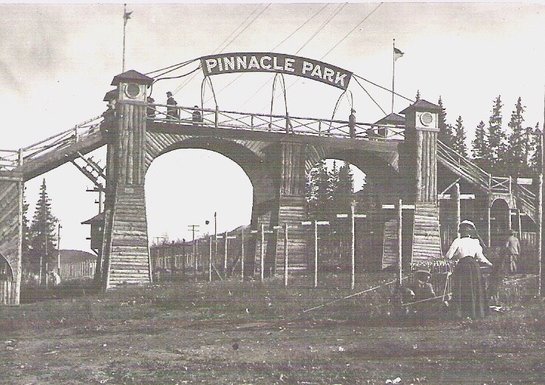 Pinnacle Park featured a zoo, merry-go-rounds, picnic areas, restaurants, a pavilion for dances and concerts, and an athletic field with a stadium for viewing ball games.
Pinnacle Park featured a zoo, merry-go-rounds, picnic areas, restaurants, a pavilion for dances and concerts, and an athletic field with a stadium for viewing ball games.
Pinnacle Park, near Cameron, was a 30-acre amusement park the Woods Investment Company established for families of their employees, as well as the citizens of the District, to enjoy outside the workplace. The Park had a picnic area, merry-go-rounds, restaurants, and a pavilion for dances and concerts. A zoo displayed bears, bobcats, and foxes. It also included an athletic field with a 1,000-seat stadium where frequent baseball and football games were played. The cost of daily admission was ten cents. The Fourth of July and Labor Day offered grand family celebrations at Pinnacle Park.
Skaguay Dam & Hydroelectric Power Plant
With advances in technology, mining operations shifted to using electricity (rather than steam generated from water in coal-fired plants) to power their equipment. The Woods Investment Company developed plans to construct the Skaguay Dam and Hydroelectric Plant on Beaver Creek to generate electricity that would be delivered by the Pikes Peak Power Company to the Gold Coin Mine as well as other customers throughout the District and beyond. In 1899, with no expense spared, 500 men were assembled in three camps to execute the project.
With advances in technology, mining operations shifted to using electricity (rather than steam generated from water in coal-fired plants) to power their equipment. The Woods Investment Company developed plans to construct the Skaguay Dam and Hydroelectric Plant on Beaver Creek to generate electricity that would be delivered by the Pikes Peak Power Company to the Gold Coin Mine as well as other customers throughout the District and beyond. In 1899, with no expense spared, 500 men were assembled in three camps to execute the project.
Skaguay Dam & Reservoir. Camp One was in charge of the rock fill and iron work required to build the steel-faced, granite-backfilled Skaguay Dam located five and one-half miles east of Victor on Beaver Creek. In length, the dam was 405 feet along the top and 220 feet at the base. In cross section, it was 148 feet at the base and 20 at the cap. The top of a nearby mountain was blown off to obtain the 110,000 cubic yards of rock and material needed to construct the dam. [Western Electrician]
Wooden Stave Pipeline. Camp two built a 23,200 feet long wooden stave Pipeline (supported by graded earth shelves, bridges and tunnels) for delivering water released from the dam to the power plant. The pipe was 30 inches in diameter and constructed of one and one-half inch redwood staves banded together with steel bands and cast-iron lugs. [Western Electrician]
Skaguay Power Plant. Camp three built the Skaguay hydro-powered plant for generating electricity in a very rugged, remote location on Beaver Creek . The plant building was constructed of brick with arched windows matching those at the Gold Coin Mine Shaft House and the Pikes Peak Power Substation, which was constructed next to the mine to transform the current to a usable voltage. Electrical equipment was supplied by the General Electric Company. [Western Electrician]
Wooden Stave Pipeline. Camp two built a 23,200 feet long wooden stave Pipeline (supported by graded earth shelves, bridges and tunnels) for delivering water released from the dam to the power plant. The pipe was 30 inches in diameter and constructed of one and one-half inch redwood staves banded together with steel bands and cast-iron lugs. [Western Electrician]
Skaguay Power Plant. Camp three built the Skaguay hydro-powered plant for generating electricity in a very rugged, remote location on Beaver Creek . The plant building was constructed of brick with arched windows matching those at the Gold Coin Mine Shaft House and the Pikes Peak Power Substation, which was constructed next to the mine to transform the current to a usable voltage. Electrical equipment was supplied by the General Electric Company. [Western Electrician]
The Hydroelectric Power Plant began operation in May of 1901 with George Kent throwing the first switch at Skaguay. Win Clark received the energy through the Pikes Peak Power Substation in Victor to put the electric locomotive into action moving though the Columbine-Victor Tunnel.
According to "Skaguay: The Miracle of the Gold Camp Near Cripple Creek & Victor" -- “To celebrate the event for the success of Skaguay, the Woods brothers waited until the 4th of July to put on a real party. Electricity was free and the streets were lit up like a Christmas tree. Old carbon-type, incandescent-type globes were ordered in by the hundreds and burned night and day. Searchlights were mounted on the Gold Coin Mine tower and their light roamed the hills and streets catching parties and dancing in their light. . . . It was a real celebration for the new boomtown and it continued for three days.”
According to "Skaguay: The Miracle of the Gold Camp Near Cripple Creek & Victor" -- “To celebrate the event for the success of Skaguay, the Woods brothers waited until the 4th of July to put on a real party. Electricity was free and the streets were lit up like a Christmas tree. Old carbon-type, incandescent-type globes were ordered in by the hundreds and burned night and day. Searchlights were mounted on the Gold Coin Mine tower and their light roamed the hills and streets catching parties and dancing in their light. . . . It was a real celebration for the new boomtown and it continued for three days.”
First National Bank of Victor
The fate of the Gold Coin Mine was also linked to the operation of the First National Bank of Victor where Frank Woods was President. The original two-story bank building was destroyed in the fire and replaced by Christmas Eve 1899 with a four-story, brick building at the same location. The bank was located on the first floor and the other three floors had rooms and office space for rent. This building eventually became known as the “New” Victor Hotel.
The fate of the Gold Coin Mine was also linked to the operation of the First National Bank of Victor where Frank Woods was President. The original two-story bank building was destroyed in the fire and replaced by Christmas Eve 1899 with a four-story, brick building at the same location. The bank was located on the first floor and the other three floors had rooms and office space for rent. This building eventually became known as the “New” Victor Hotel.
Woods Empire Collapses
Bank Fails. The First National Bank of Victor ran into problems. In November 1902, Frank Woods blamed withdrawals by men who were leaving the District due to the Western Federation of Miners strike. This may have been the beginning of the Woods Investment Company’s downfall. With all the simultaneous projects (a comprehensive list is too long to include here), they were overstretched financially. The bank was forced to close its doors permanently on November 3, 1903 when bank examiners declared it insolvent. Several successor banks, including A.E. Carlton's City Bank, occupied the bank building and it eventually became known as the “New” Victor Hotel.
Labor Strike. The Gold Coin Mine temporarily shut down on September 30, 1903 due to the strike. This impacted 100 men working at the Gold Coin Mine, 60 at the Economic Mill, as well as 100 men leasing on the Gold Coin property. Up to this point in the strike, the Gold Coin had continued operations while many other mines in the District had shut down. The Labor Wars affected all the mines, causing closures throughout the District at one time or another.
Water Problems. As with most mines in the District, the Gold Coin reported additional, serious issues with water levels. As they worked deeper, water stopped operations. By this time in 1904, the mine had produced $6,000,000 since incorporating in 1895.
Mine Tours. In a brochure titled "An Underground Scenic Trip in the World’s Greatest Gold Camp," the Cripple Creek District Excursion Company offered a trip into the “Bowels of the Earth by Steam and Electricity.” This excursion could be purchased for $1 and many made the trip to the District aboard the steam-powered Short Line Railroad from Colorado Springs. The price of admission included a trip down into the Gold Coin Mine and a ride through the Columbine-Victor Tunnel to the Economic Mill on board the electric trolley. An additional 50 cents would include an official party photo. Children were not allowed. The brochure has a handwritten date of August 28, 1905, and lists the Woods Investment Company as the controller of the underground tour – perhaps a last ditch effort to tap revenue from tourism?
Bank Fails. The First National Bank of Victor ran into problems. In November 1902, Frank Woods blamed withdrawals by men who were leaving the District due to the Western Federation of Miners strike. This may have been the beginning of the Woods Investment Company’s downfall. With all the simultaneous projects (a comprehensive list is too long to include here), they were overstretched financially. The bank was forced to close its doors permanently on November 3, 1903 when bank examiners declared it insolvent. Several successor banks, including A.E. Carlton's City Bank, occupied the bank building and it eventually became known as the “New” Victor Hotel.
Labor Strike. The Gold Coin Mine temporarily shut down on September 30, 1903 due to the strike. This impacted 100 men working at the Gold Coin Mine, 60 at the Economic Mill, as well as 100 men leasing on the Gold Coin property. Up to this point in the strike, the Gold Coin had continued operations while many other mines in the District had shut down. The Labor Wars affected all the mines, causing closures throughout the District at one time or another.
Water Problems. As with most mines in the District, the Gold Coin reported additional, serious issues with water levels. As they worked deeper, water stopped operations. By this time in 1904, the mine had produced $6,000,000 since incorporating in 1895.
Mine Tours. In a brochure titled "An Underground Scenic Trip in the World’s Greatest Gold Camp," the Cripple Creek District Excursion Company offered a trip into the “Bowels of the Earth by Steam and Electricity.” This excursion could be purchased for $1 and many made the trip to the District aboard the steam-powered Short Line Railroad from Colorado Springs. The price of admission included a trip down into the Gold Coin Mine and a ride through the Columbine-Victor Tunnel to the Economic Mill on board the electric trolley. An additional 50 cents would include an official party photo. Children were not allowed. The brochure has a handwritten date of August 28, 1905, and lists the Woods Investment Company as the controller of the underground tour – perhaps a last ditch effort to tap revenue from tourism?
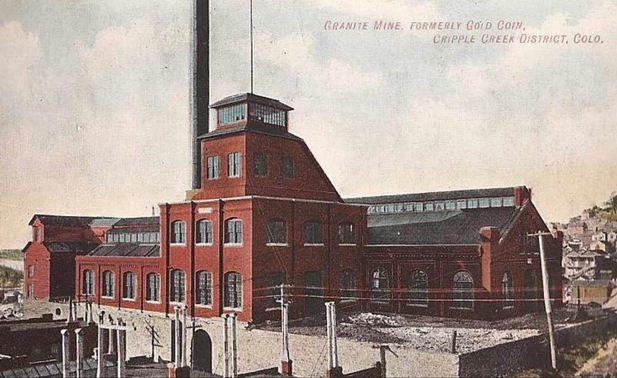 This hand tinted postcard (about 1907) indicates at this time the Gold Coin Mine has been acquired by the Granite Mine. Photo contributed by La Jean Greeson.
This hand tinted postcard (about 1907) indicates at this time the Gold Coin Mine has been acquired by the Granite Mine. Photo contributed by La Jean Greeson.
Gold Coin Sold to Granite. The Gold Coin Mine sold later that year and the "Engineering & Mining Journal" of December 9, 1905 stated: "The property of the Gold Coin Mining & Leasing Co., at Cripple Creek, has been transferred to the Granite Gold Mining Co., whose property adjoins it to the north. The Granite Co. is a close (nearby) corporation controlled by prominent parties at Colorado Strings, among them (Charles) Tutt & (Spencer) Penrose and Charles M. McNeill, and has been a heavy shipper for some time. The plan is to work the Granite mine after this, through the Gold Coin shaft, from the 900-ft. level. It is not possible to state the price at which the sale was made, but as the plant of the Gold Coin mine alone represents an original outlay of about $200,000, a large amount is involved. It is generally understood that the mill of the Economic Gold Extraction Co., situated at the mouth of the tunnel, through which the Gold Coin property has been partially operated, is not included in the sale."
Economic Mill Burns. The January 31, 1907 edition of the "Aspen Daily Times" reported: "Victor, Colo., Jan. 30.---An early morning fire today destroyed the mill of the Economic Reduction company, the largest in the district, located in Eclipse Gulch. The loss is said to be about $500,000 with little insurance. The authorities of this city and Cripple Creek have begun an investigation on the theory that the blaze was the work of incendiaries. Owing to the fact that the flames had almost enveloped all of the mammoth structure before being discovered, the plant was burned to the ground, destroying every vestige of a clue that might have been left by firebugs. The mill was known as the Economic Gold Extraction Works, a chlorination plant, and was erected in 1897 at a cost of $532,000. Recently it closed down and has since been idle."
Woods Family Exits. It was sometime after this fire that the Woods took their departure from Victor, the “City of Mines.” It must have been devastating to not only lose their fortune, but to leave the city that they helped build and, literally, placed on the map.
Gold Coin Machinery Removed. In 1919, the "Mining and Scientific Press" reported in their November 1st edition: "The machinery at the Gold Coin shaft of the Granite Gold Mining Co., situated in the city of Victor, is to be dismantled and sold. The plant was one of the most costly ever installed in the district. The veins of the Gold Coin have been worked out to the bottom or 1200-ft. level, and except for scattered bunches of ore now being cleaned up by lessees, no work is being done on this end of the property.”
Shaft House Dismantled. In 1920, the December 12 edition states: “The former plant of the Gold Coin shaft, believed the most costly in this district, constructed at a cost of $260,000, is now being dismantled and the building, a steel and pressed-brick structure in the city of Victor, will be wrecked. The hoist and compressor have been sold; it is understood, to the Portland Company. The Granite Gold Mining Co. has centralized operations at the Dillon shaft on Battle Mountain.”
Gold Coin Resold. In 1926, the mine’s depth had only reached 1,300 feet and the Gold Coin Mine was purchase by the International Gold Mining Company. Sometime around 1935, the Golden Cycle Corporation bought the mine along with Granite, Ajax, and Sunshine Sedan for $80,000. Today the Gold Coin property is owned by the Newmont's Cripple Creek & Victor Mining Company.
Warren Woods, the family patriarch, died in Los Angeles in 1918 at 84 years of age. Harry enjoyed a moderate success, dying in 1924 in Laguna Beach, California. Frank met with several tragedies that included losing his son in a cave-in at the Golden Cycle Mine, and the deaths of his daughter and two wives. He died in Los Angeles in 1932, reportedly “so poor that his friends raised money to bury him." [Sprague]
Woods Family Exits. It was sometime after this fire that the Woods took their departure from Victor, the “City of Mines.” It must have been devastating to not only lose their fortune, but to leave the city that they helped build and, literally, placed on the map.
Gold Coin Machinery Removed. In 1919, the "Mining and Scientific Press" reported in their November 1st edition: "The machinery at the Gold Coin shaft of the Granite Gold Mining Co., situated in the city of Victor, is to be dismantled and sold. The plant was one of the most costly ever installed in the district. The veins of the Gold Coin have been worked out to the bottom or 1200-ft. level, and except for scattered bunches of ore now being cleaned up by lessees, no work is being done on this end of the property.”
Shaft House Dismantled. In 1920, the December 12 edition states: “The former plant of the Gold Coin shaft, believed the most costly in this district, constructed at a cost of $260,000, is now being dismantled and the building, a steel and pressed-brick structure in the city of Victor, will be wrecked. The hoist and compressor have been sold; it is understood, to the Portland Company. The Granite Gold Mining Co. has centralized operations at the Dillon shaft on Battle Mountain.”
Gold Coin Resold. In 1926, the mine’s depth had only reached 1,300 feet and the Gold Coin Mine was purchase by the International Gold Mining Company. Sometime around 1935, the Golden Cycle Corporation bought the mine along with Granite, Ajax, and Sunshine Sedan for $80,000. Today the Gold Coin property is owned by the Newmont's Cripple Creek & Victor Mining Company.
Warren Woods, the family patriarch, died in Los Angeles in 1918 at 84 years of age. Harry enjoyed a moderate success, dying in 1924 in Laguna Beach, California. Frank met with several tragedies that included losing his son in a cave-in at the Golden Cycle Mine, and the deaths of his daughter and two wives. He died in Los Angeles in 1932, reportedly “so poor that his friends raised money to bury him." [Sprague]
Gold Coin Mine Remnants & Legacy of Woods Family Empire
What remains today of the Woods family empire? The shortest, glib answer might be three magnificent buildings, a dam, and a city. At the site of the Gold Coin Mine, which provided much of the “seed” money for developing the family empire, all that remains is the rubble-stone foundation and interpretive signage with information about the mine and vintage mining equipment.
Remnants of the Economic Mill and the Portal of the Columbine Tunnel remained visible into the 1990s. Expansion of a huge leach pad for large-scale surface mining now completely fills the valley that once lay below the Mill. The leach pad covers the Mill site and is taller than Squaw Mountain. Talk of restoring and reopening the Columbine-Victor Tunnel and tram faded into another illusory dream for developing heritage tourism.
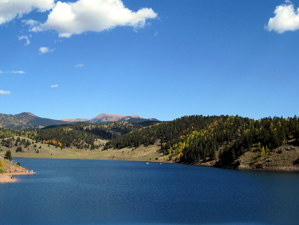 The Skaguay Reservoir, built by the Woods family, survived several floods and is now a popular recreation area.
The Skaguay Reservoir, built by the Woods family, survived several floods and is now a popular recreation area.
The Skaguay Dam, Reservoir and Hydroelectric Power Plant are now part of a State Wildlife and Wilderness Study Area. Now managed by Colorado State Parks and Wildlife, the area is popular with those who enjoy camping, fishing, and hiking.
The hydroelectric power generating facilities continued in operation until 1965 when a flood weakened the dam, filled the wooden-stave pipeline with silt, and caused other extensive damages that led to abandonment of the power plant.
The hydroelectric power generating facilities continued in operation until 1965 when a flood weakened the dam, filled the wooden-stave pipeline with silt, and caused other extensive damages that led to abandonment of the power plant.
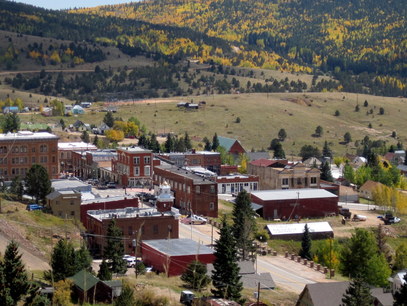 In 1985 the "Downtown Victor Historic District" was listed on the National Register of Historic Places. At that time it contained 66 relatively unaltered and contiguous commercial, public, fraternal, and religious buildings of late 19th and early 20th century design. The predominant historic character of the entire "City of Gold Mines" remains a lasting tribute to its founders--Warren, Harry, and Frank Woods.
In 1985 the "Downtown Victor Historic District" was listed on the National Register of Historic Places. At that time it contained 66 relatively unaltered and contiguous commercial, public, fraternal, and religious buildings of late 19th and early 20th century design. The predominant historic character of the entire "City of Gold Mines" remains a lasting tribute to its founders--Warren, Harry, and Frank Woods.
Of course the lasting legacy of the Woods family empire is far more than three magnificent buildings and a dam. The City of Victor itself was established and platted by the Woods family. They also donated land for building several schools, the Baptist Church (still serving a congregation) and several other churches.
Today the “City of Mines” is a mere shadow of what it was in the booming gold rush days of the late 1890s and early 1900s. However, it is widely recognized for the authenticity of its turn-of-the-century appearance by the National Trust for Historic Preservation and State of Colorado Historic Preservation entities. Victor still reflects the great wealth and prosperity that resulted from early days underground hardrock gold mining operations like the Gold Coin Mine.
Today the “City of Mines” is a mere shadow of what it was in the booming gold rush days of the late 1890s and early 1900s. However, it is widely recognized for the authenticity of its turn-of-the-century appearance by the National Trust for Historic Preservation and State of Colorado Historic Preservation entities. Victor still reflects the great wealth and prosperity that resulted from early days underground hardrock gold mining operations like the Gold Coin Mine.
Compiled and Submitted by La Jean Greeson, March 2017.
ABOUT THE AUTHOR & MAJOR CONTRIBUTOR:
La Jean Greeson's family ties to Victor and the Mining District originate before 1900 when her great-great grandparents came to the area. Her grandparents, Buster and Emma Peters, became first-time homeowners in 1940 at 107 Portland Avenue in Victor where their children, Gladys (La Jean's mother) and Pepper, were raised into their teenage years. Bus worked underground in the Vindicator Mine and also helped construct the Carlton Mill for the Golden Cycle Corporation. But frequently he was obliged to seek employment opportunities outside the District--Hawaii (for a tunnel job), and Grants, New Mexico (a uranium mining boom town where he started a welding business). In 1956 the Peters family moved permanently to New Mexico, but returned for visits to their Victor home into the 1970s. La Jean grew up hearing their stories and developed a passion for Victor history that blossomed into a Facebook page featuring historic Victor photos.
La Jean now lives in Bremerton, Washington and visits Victor as often as possible. As an active Victor Heritage Society member, La Jean has generously volunteered to serve as our Family Research Coordinator, and to spearhead coordinating the research and photos for this Gallery of Historic Underground Mines near Victor.
Linda Irene Tingvik became fascinated with the mining history and railroads that once served the Cripple Creek Mining District. She has assembled an amazing collection of photos and information that can be viewed through her web site, CrippleCreekRailroads.Com. From her home in Norway, Linda has generously shared her knowledge and many photos featured in this story about the Gold Coin Mine and the Woods empire. Her passion for the history of the Gold Camp is enhanced by "eyes on" vacation visits to see what it looks like today.
Sources:
Contact VHS or La Jean Greeson to share early photos of historic underground gold mines near Victor, or to share a story about someone (perhaps a relative) who worked in the underground mines.
La Jean Greeson's family ties to Victor and the Mining District originate before 1900 when her great-great grandparents came to the area. Her grandparents, Buster and Emma Peters, became first-time homeowners in 1940 at 107 Portland Avenue in Victor where their children, Gladys (La Jean's mother) and Pepper, were raised into their teenage years. Bus worked underground in the Vindicator Mine and also helped construct the Carlton Mill for the Golden Cycle Corporation. But frequently he was obliged to seek employment opportunities outside the District--Hawaii (for a tunnel job), and Grants, New Mexico (a uranium mining boom town where he started a welding business). In 1956 the Peters family moved permanently to New Mexico, but returned for visits to their Victor home into the 1970s. La Jean grew up hearing their stories and developed a passion for Victor history that blossomed into a Facebook page featuring historic Victor photos.
La Jean now lives in Bremerton, Washington and visits Victor as often as possible. As an active Victor Heritage Society member, La Jean has generously volunteered to serve as our Family Research Coordinator, and to spearhead coordinating the research and photos for this Gallery of Historic Underground Mines near Victor.
Linda Irene Tingvik became fascinated with the mining history and railroads that once served the Cripple Creek Mining District. She has assembled an amazing collection of photos and information that can be viewed through her web site, CrippleCreekRailroads.Com. From her home in Norway, Linda has generously shared her knowledge and many photos featured in this story about the Gold Coin Mine and the Woods empire. Her passion for the history of the Gold Camp is enhanced by "eyes on" vacation visits to see what it looks like today.
Sources:
- Clark, Winfred Ward. Skaguay: The Miracle of the Gold Camp Near Cripple Creek & Victor. Century One Press, 1989.
- The Cripple Creek District Excursion Company. An Underground Scenic Trip in the World’s Greatest Gold Camp. 1905.
- Engineering & Mining Journal, December 9, 1905.
- Evening Telegraph, Fortunes of a Decade., Colorado Springs, 1900.
- Feitz, Leland. Victor: A Quick History. Colorado Springs, CO: Little London Press, 1968.
- Jameson, Elizabeth. All That Glitters: Class, Conflict, and Community in Cripple Creek. Chicago: Board of Trustees of the University of Illinois, 1998.
- Linddgren, Waldemar, & Ransome. Geology and Gold Deposits of the Cripple Creek District, Colorado. Books.google.com, January 1, 1906.
- Mackell, Jan (Collins). Cripple Creek District: Last of Colorado’s Gold Booms. Charleston SC: Arcadia Publishing, 2003.
- Mines & Minerals Journal, February 1901.
- Mining & Scientific Press, November 1, 1919, December 12, 1920.
- Munn, Bill. A Guide to the Mines of the Cripple Creek District. 1984.
- Porter, Rufus L. Pay Dirt, The Hard Rock Poet’s Latest Tales and Ballads about The World’s Greatest Gold Camp, 1961.
- Sprague, Marshall. Money Mountain. Lincoln, NE: University of Nebraska Press, 1953.
- Tingvik, Linda Irene. CrippleCreekRailroads.Com.
- Victor Centennial Committee. Victor Centennial Commemorative Book, 1893-1993. Victor, CO. Poco Libro Press, 1993.
- Western Electrician Journal, August 2, 1902.
- Woods Investment Company. The Cripple Creek Mining District, 1900 – 1901. CrippleCreekRailroads.Com.
- Woods Investment Company. Goldfields of Cripple Creek: Pan-American Exposition, Buffalo, New York, 1901. CrippleCreekRailroads.Com.
Contact VHS or La Jean Greeson to share early photos of historic underground gold mines near Victor, or to share a story about someone (perhaps a relative) who worked in the underground mines.
THE PAST MATTERS. PASS IT ALONG. The Next Generation Will Only Inherit What We Choose To Save.
Some people say,
"In a small town there is not much to see, but what you hear makes up for it."
In historic Victor, Colorado there is plenty to see and hear.
Come take a look--and a listen!
Click Here to View the Story of Stratton's Independence Mine
Click Here to View a Photo Gallery Documenting Restoration of the Independence Mine Headframe
Click Here for the Story of the Vindicator Mine
Click Here to View a Photo Gallery: Historic Victor Residential Gems
Click Here to View a Photo Gallery: Victor Businesses Operating in Historic Structures
Click Here to View a Photo Gallery: This Old Victor House/Building--Then & Now
Click Here to View a Booklet: Guidelines for Preserving Our Architectural Heritage
"In a small town there is not much to see, but what you hear makes up for it."
In historic Victor, Colorado there is plenty to see and hear.
Come take a look--and a listen!
Click Here to View the Story of Stratton's Independence Mine
Click Here to View a Photo Gallery Documenting Restoration of the Independence Mine Headframe
Click Here for the Story of the Vindicator Mine
Click Here to View a Photo Gallery: Historic Victor Residential Gems
Click Here to View a Photo Gallery: Victor Businesses Operating in Historic Structures
Click Here to View a Photo Gallery: This Old Victor House/Building--Then & Now
Click Here to View a Booklet: Guidelines for Preserving Our Architectural Heritage
VictorHeritageSociety.com
Copyright © 2023 Victor Heritage Society. All Rights Reserved.
Copyright © 2023 Victor Heritage Society. All Rights Reserved.
